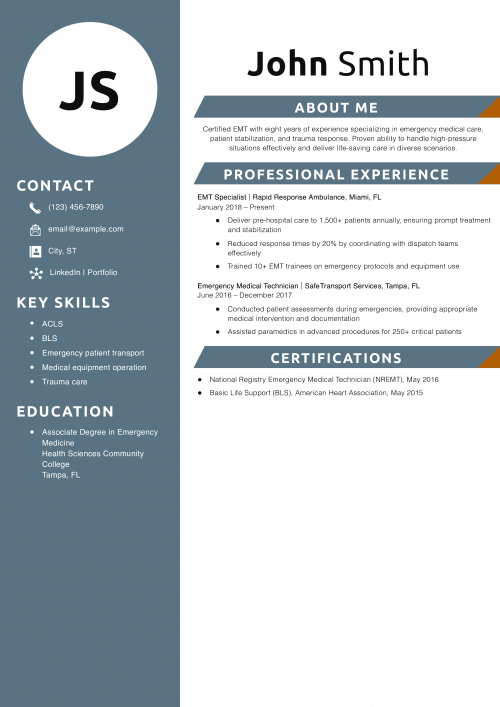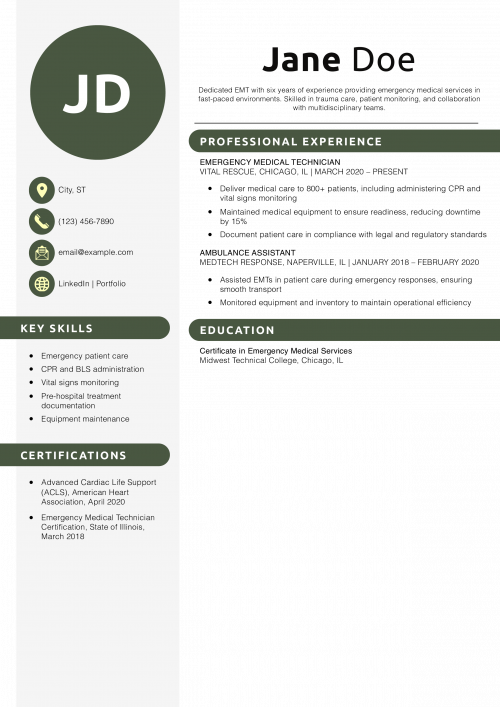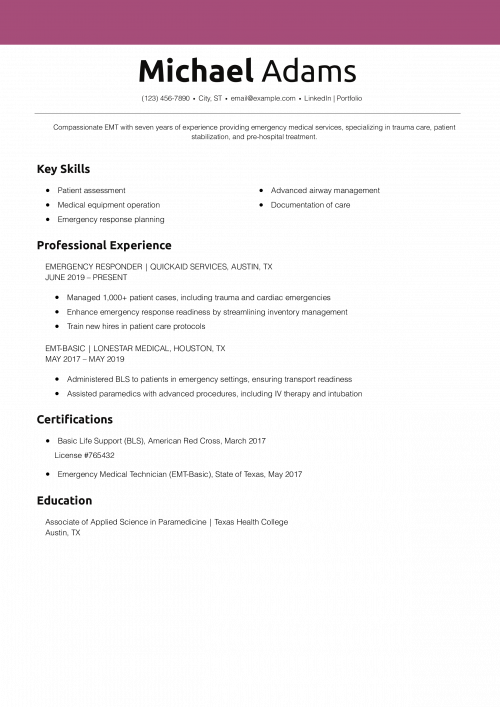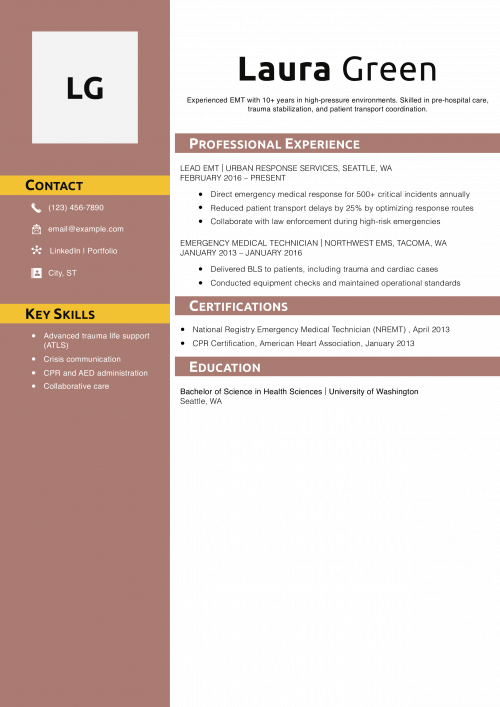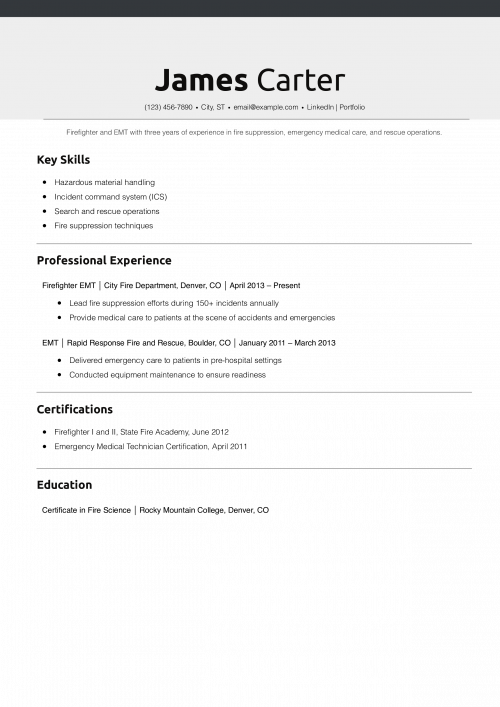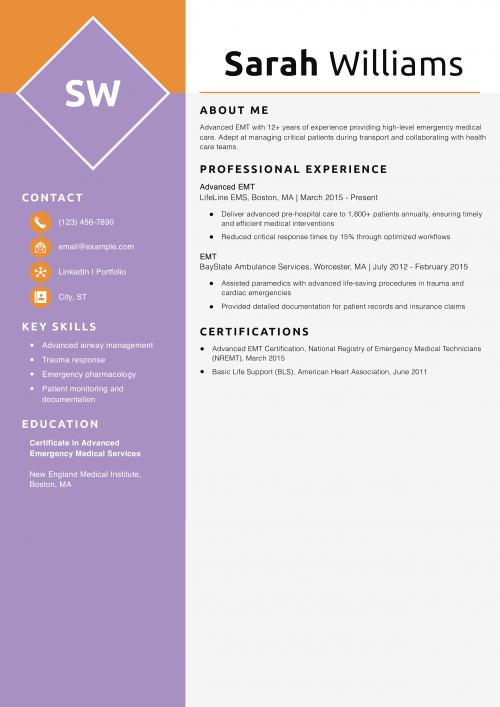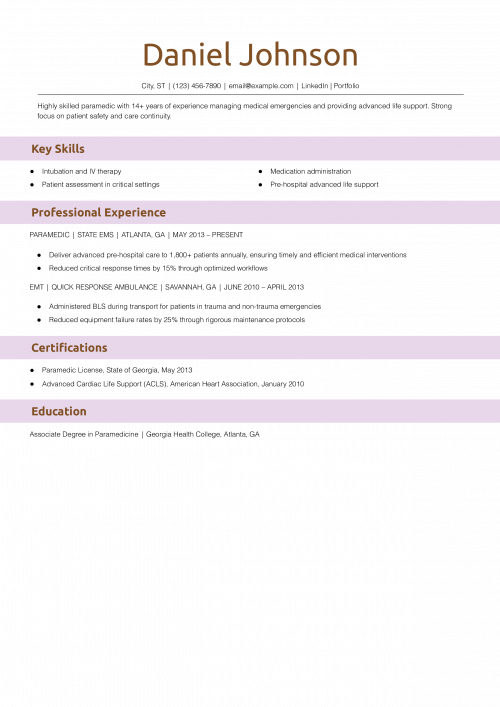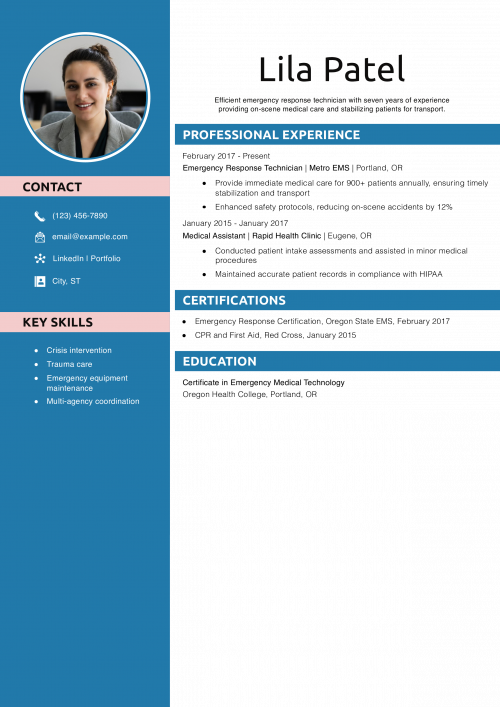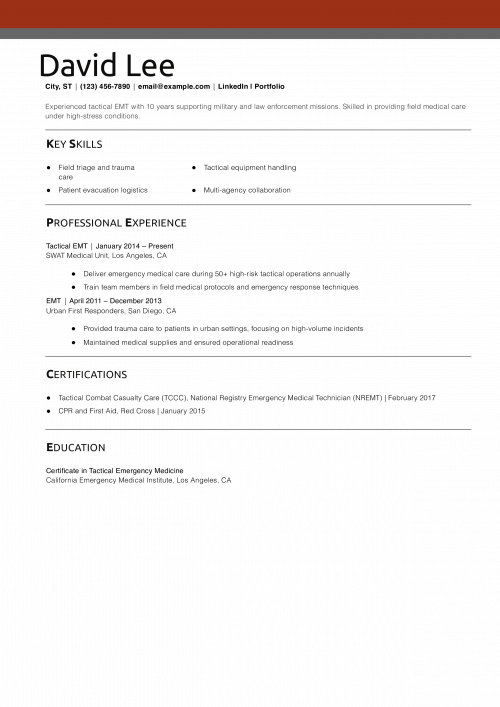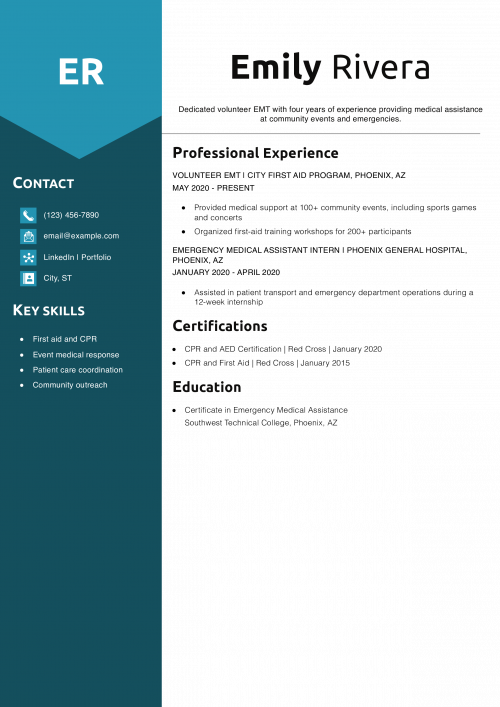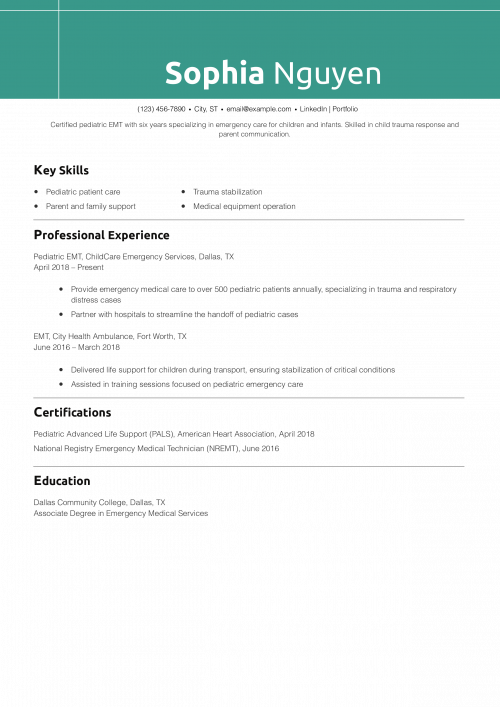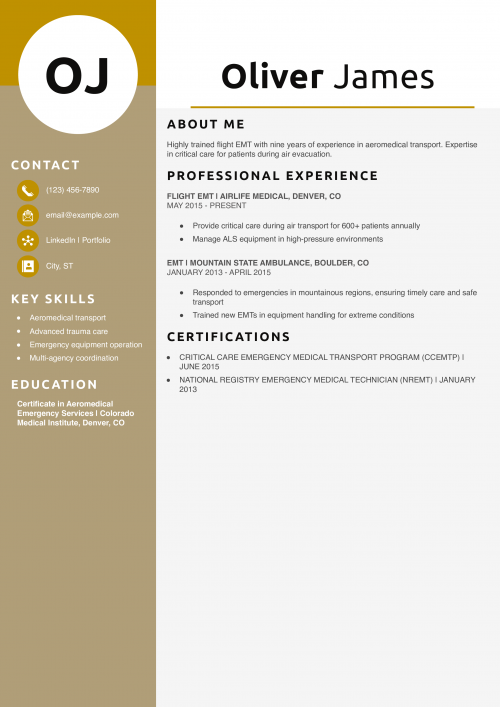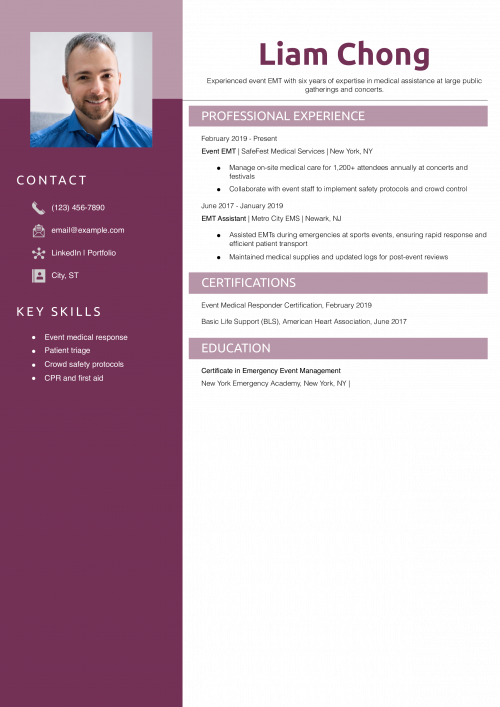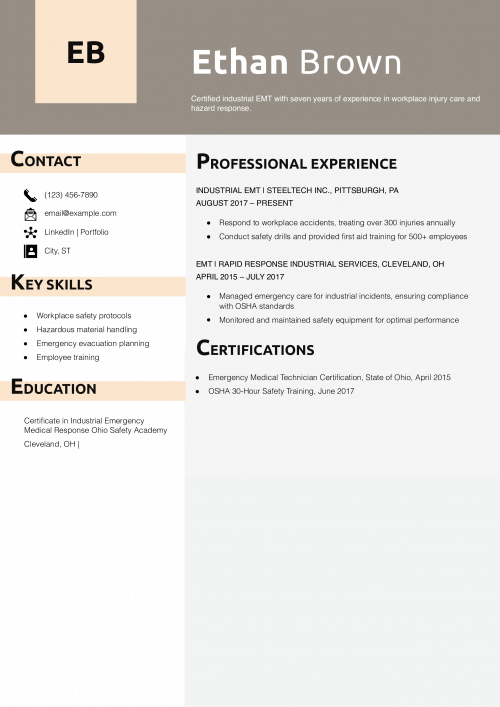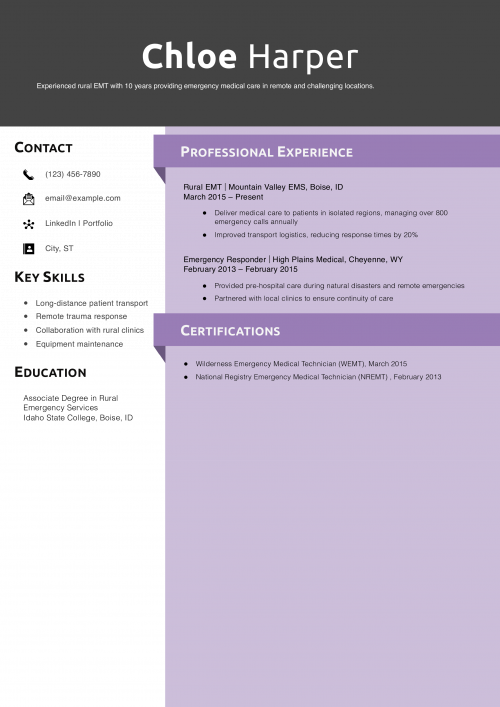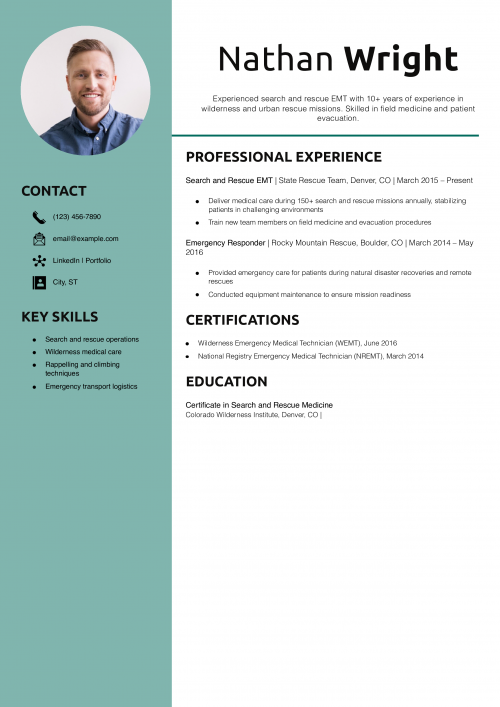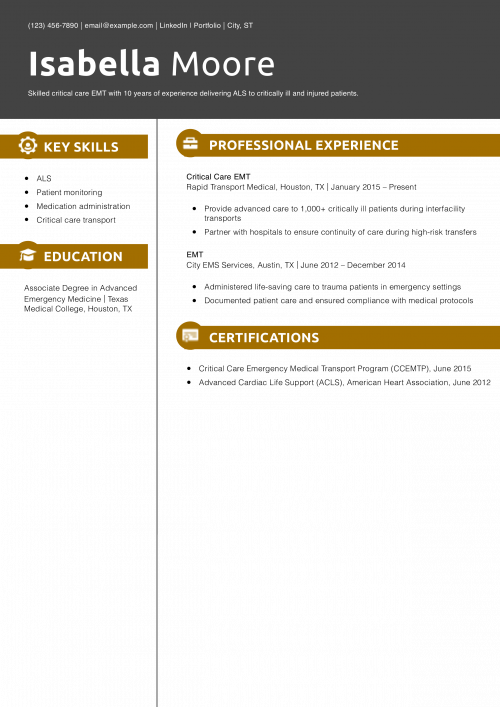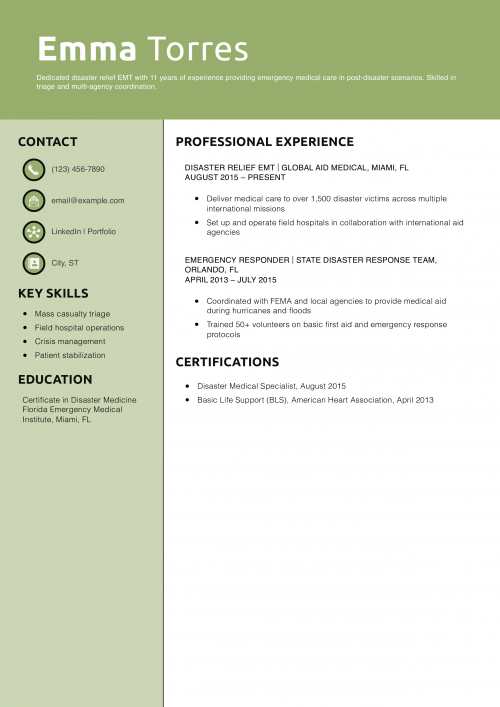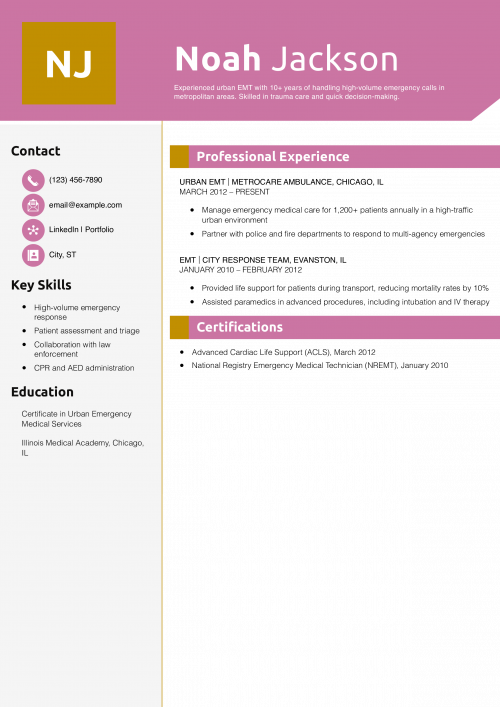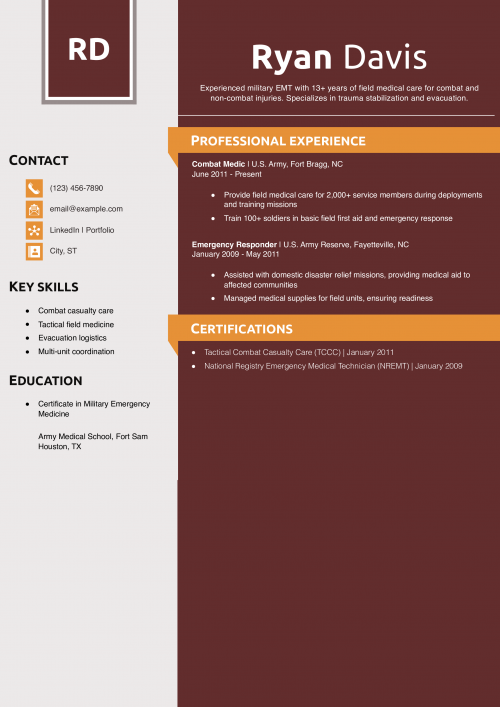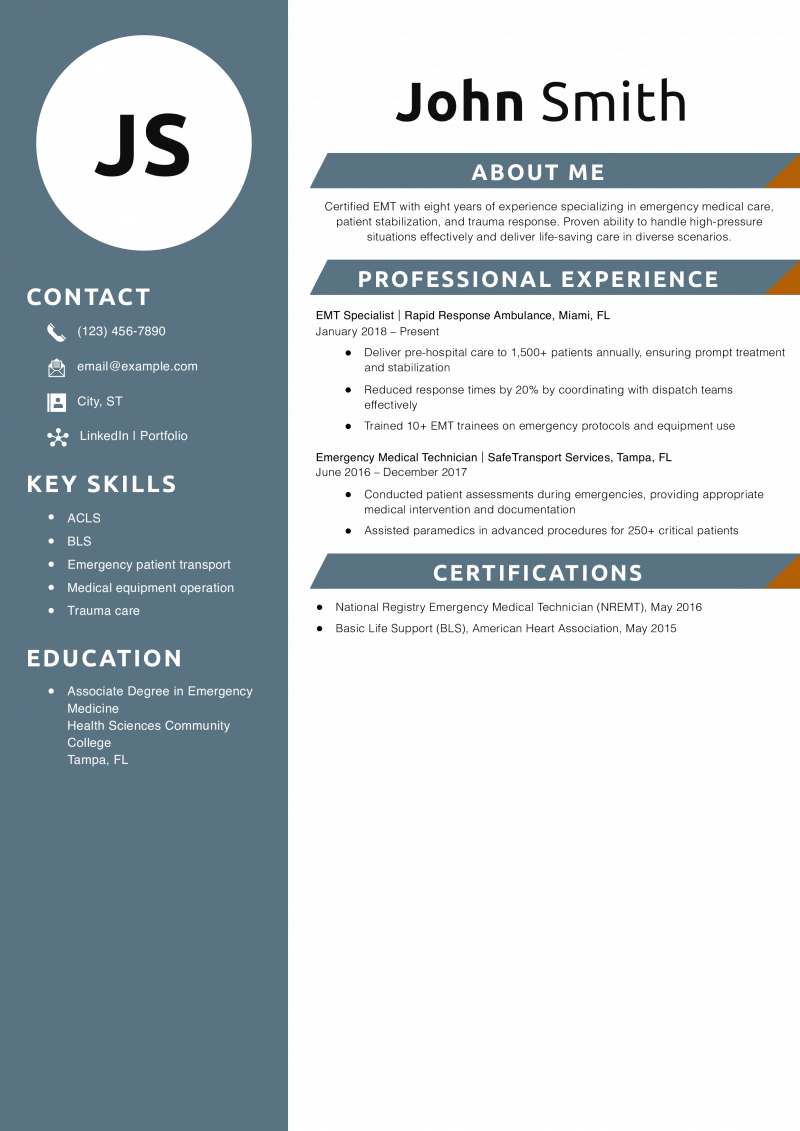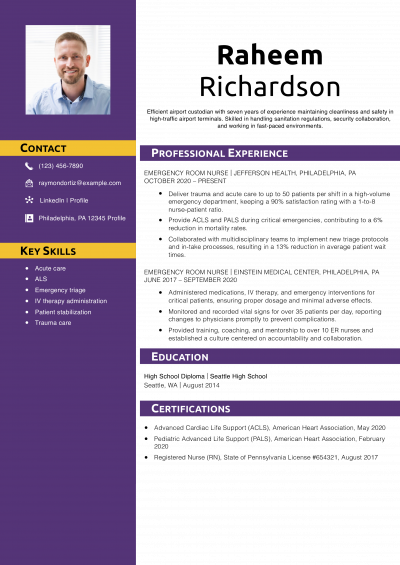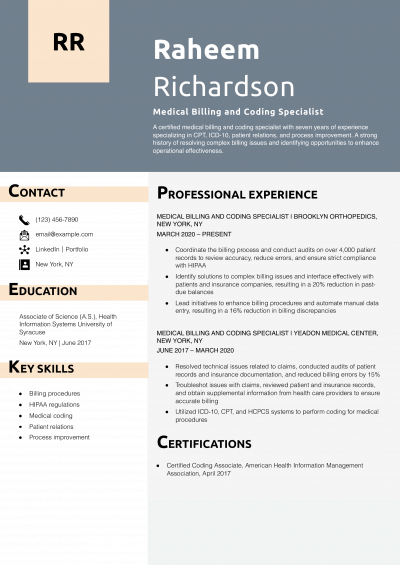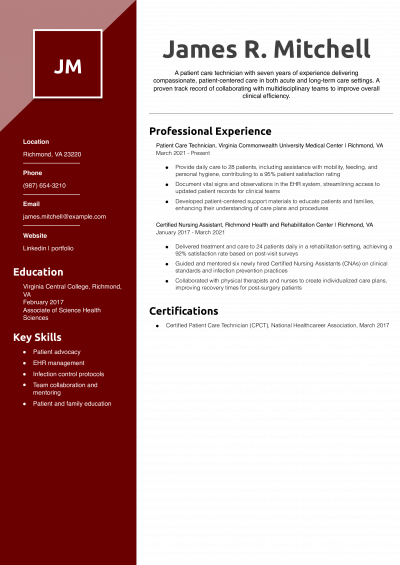A good emergency medical technician (EMT) resume focuses on your relevant skills, like basic life support (BLS), trauma response, and patient transport. Give examples of your success as an EMT or in similar roles, and show your knowledge base by citing the training or certificate programs you’ve done. This guide provides expert tips to help you create a results-driven resume showing your best EMT qualifications.
Key takeaways:
- Brainstorm details about your work history on a separate document or sheet of paper. Then, identify the most relevant ones to feature in your experience section – this helps you focus your resume on the role of EMT.
- Spell out the results of your past work as an EMT. Describe how your efforts helped patients, colleagues, and the wider organization.
- Use bullet points to display your achievements. Start each bullet point with a strong verb like “Created,” “Prevented,” or “Enhanced.”
Most Popular EMT Resumes
EMT Duties Resume Example
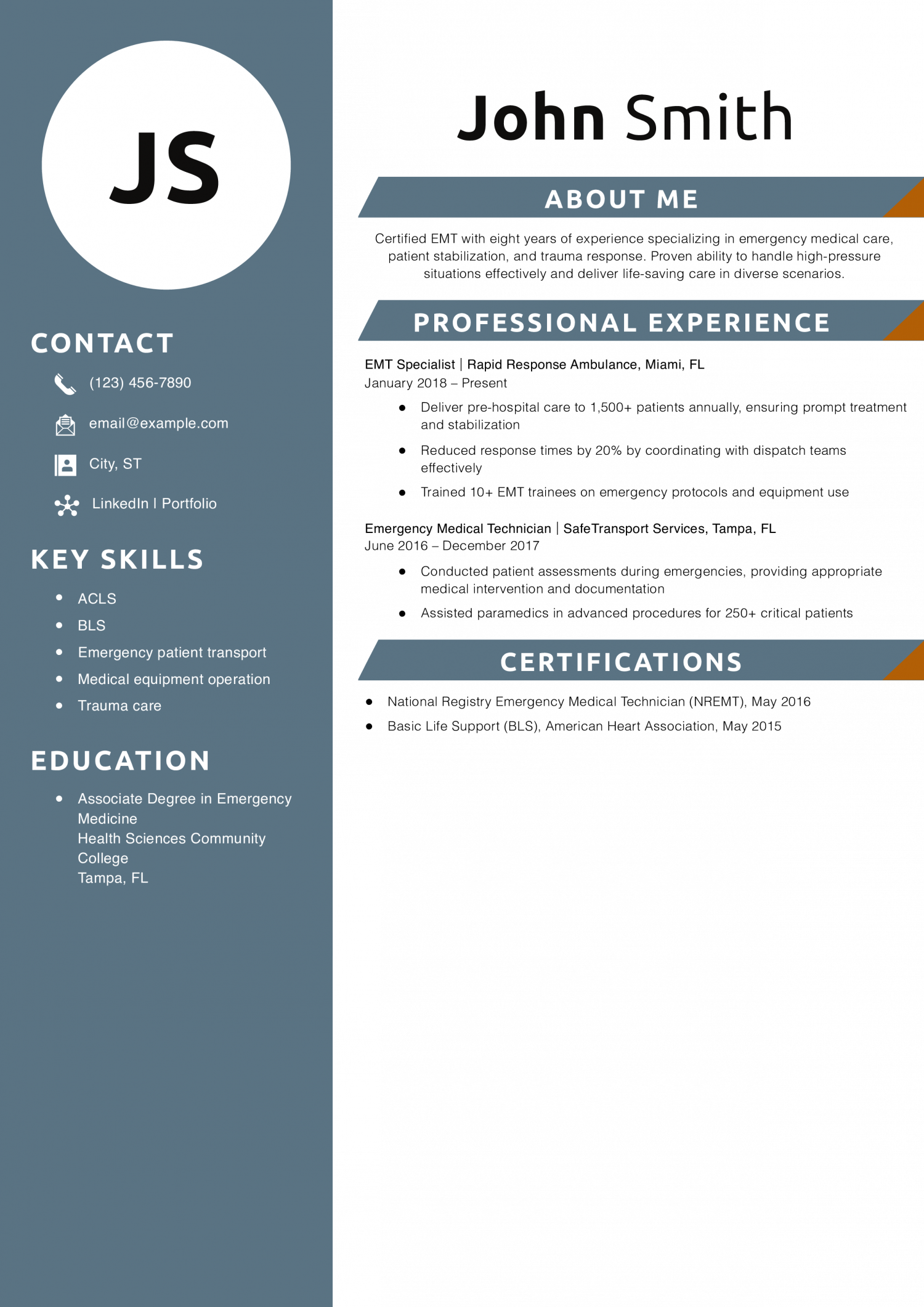
Why this EMT duties resume example is strong:
This resume highlights key accomplishments like reducing response times and training new EMTs, demonstrating leadership and impact. Its clear layout and specific metrics align with advice from Resume Templates. For more on how to make a resume, click here.
EMT Responsibilities Resume Example
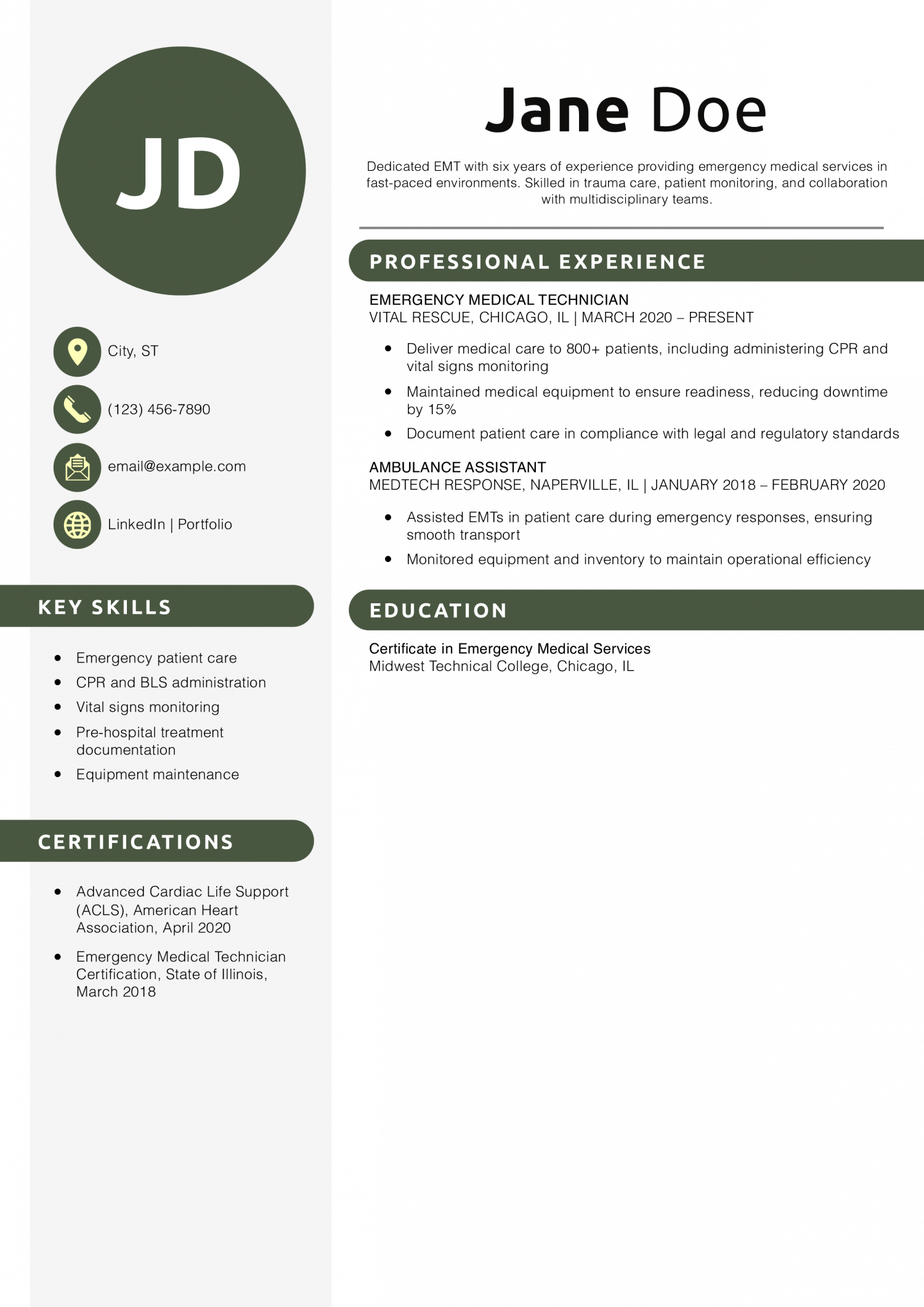
Why this EMT responsibilities resume example is strong:
This resume effectively outlines core responsibilities and quantifies patient care, supported by certifications. The focused skills list ensures alignment with hiring needs, as advised by Resume Templates.
EMT Resume Skills Example
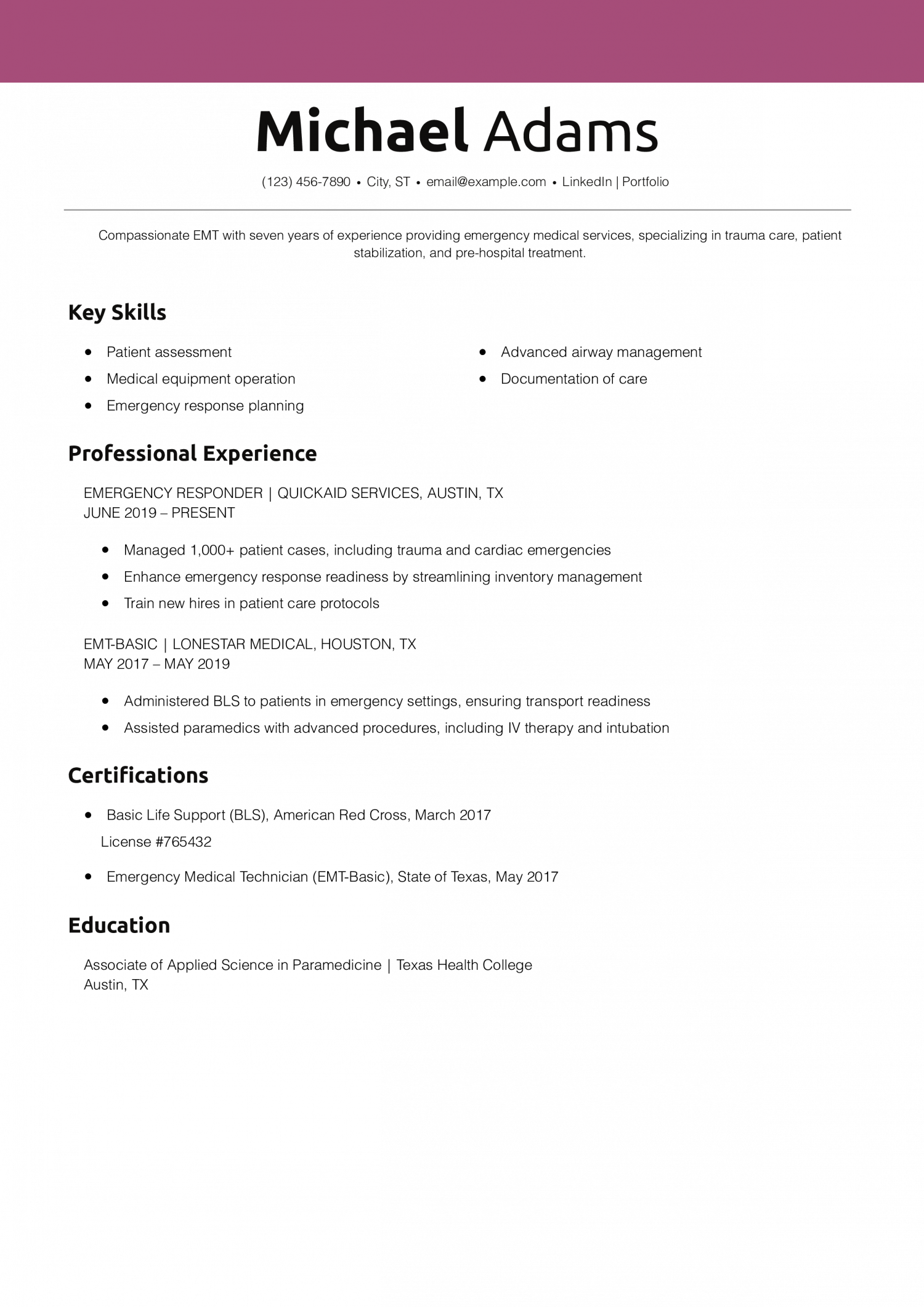
Why this EMT resume skills example is strong:
This example focuses on critical skills and training, with quantifiable achievements to showcase impact. Its clear layout follows best practices outlined by Resume Templates.
EMT Resume PDF Example
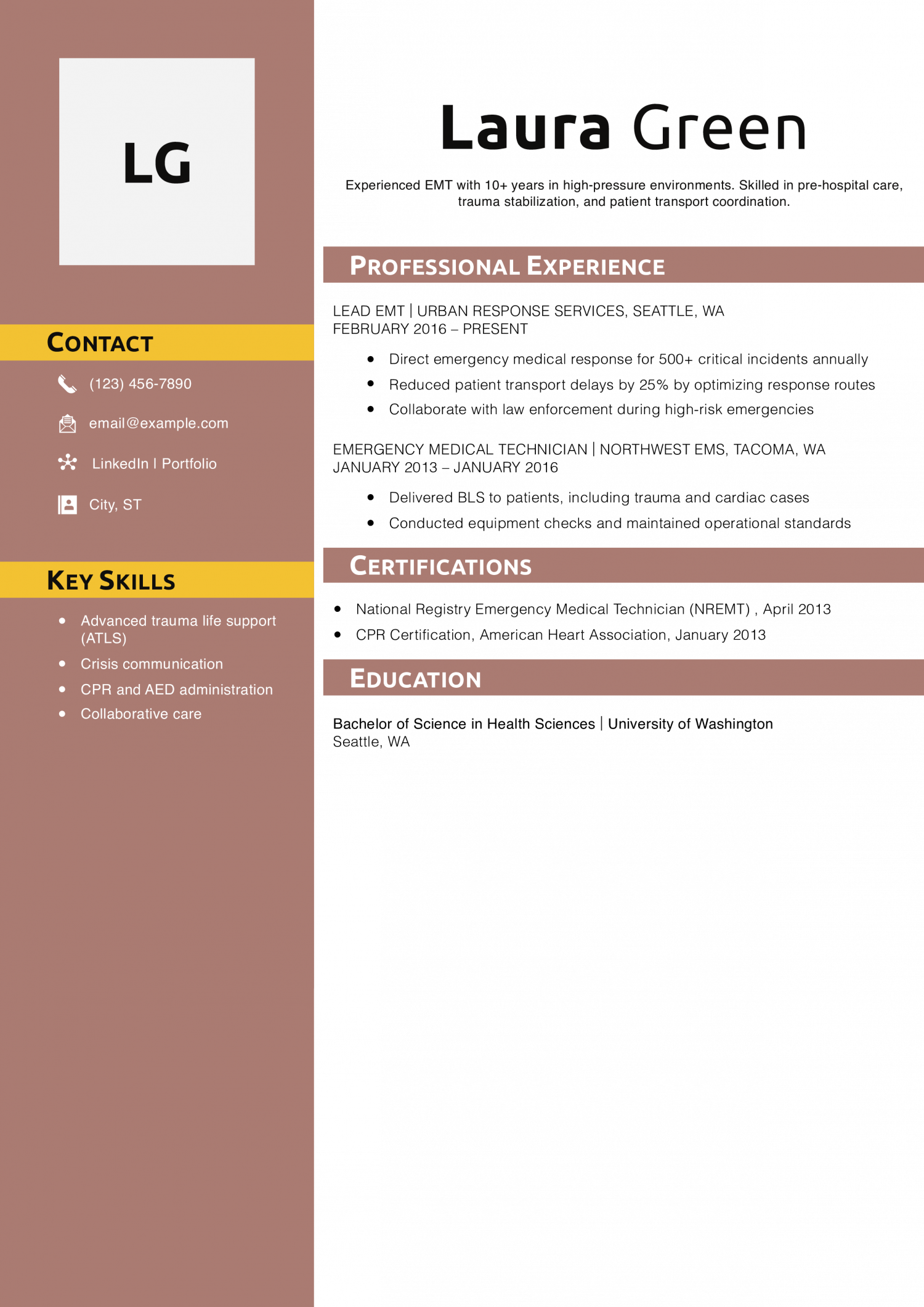
Why this EMT resume PDF example is strong:
This resume combines a clear summary, leadership achievements, and specific skills, ideal for PDF formats. For examples of resume objectives, click here.
Firefighter EMT Resume Example
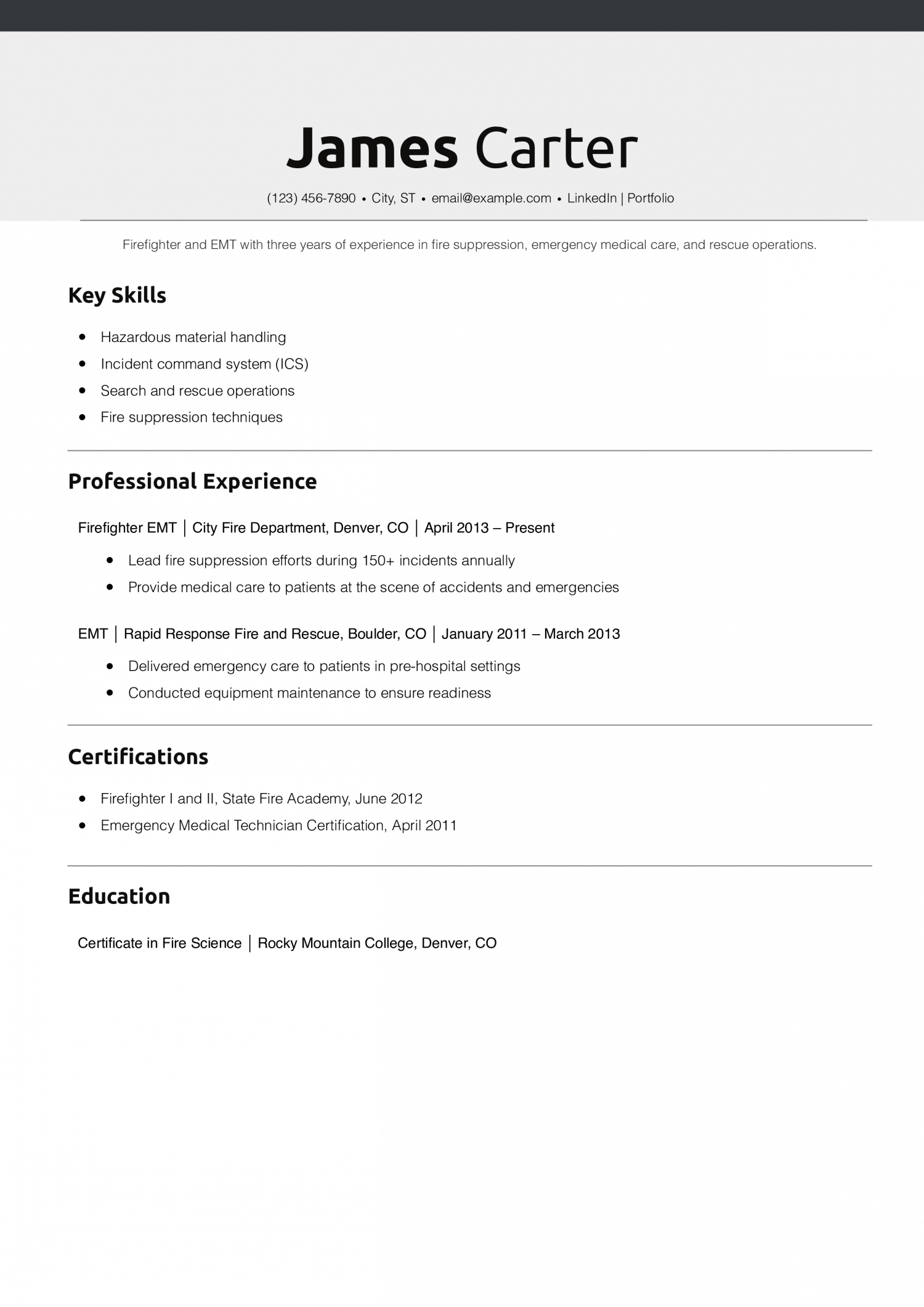
Why this firefighter EMT resume example is strong:
This resume balances firefighting and EMT skills with quantifiable successes in both fields. Its summary aligns with expert tips from Resume Templates.
Advanced EMT Resume Example
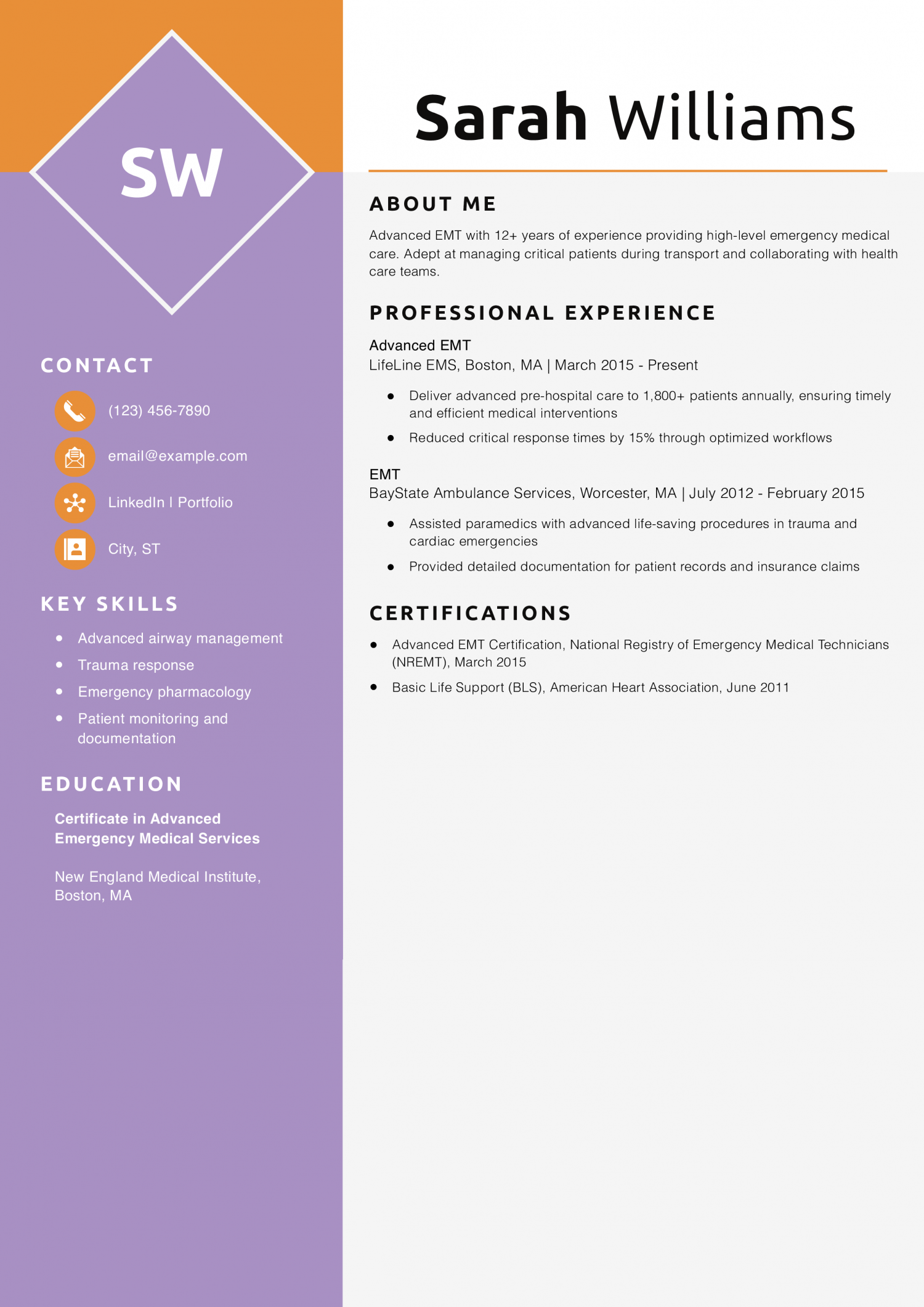
Why this advanced EMT resume example is strong:
This resume highlights advanced skills and certifications, showcasing specific contributions to patient care. It aligns with advice from Resume Templates on what to include on a resume.
EMT-Paramedic Resume Example
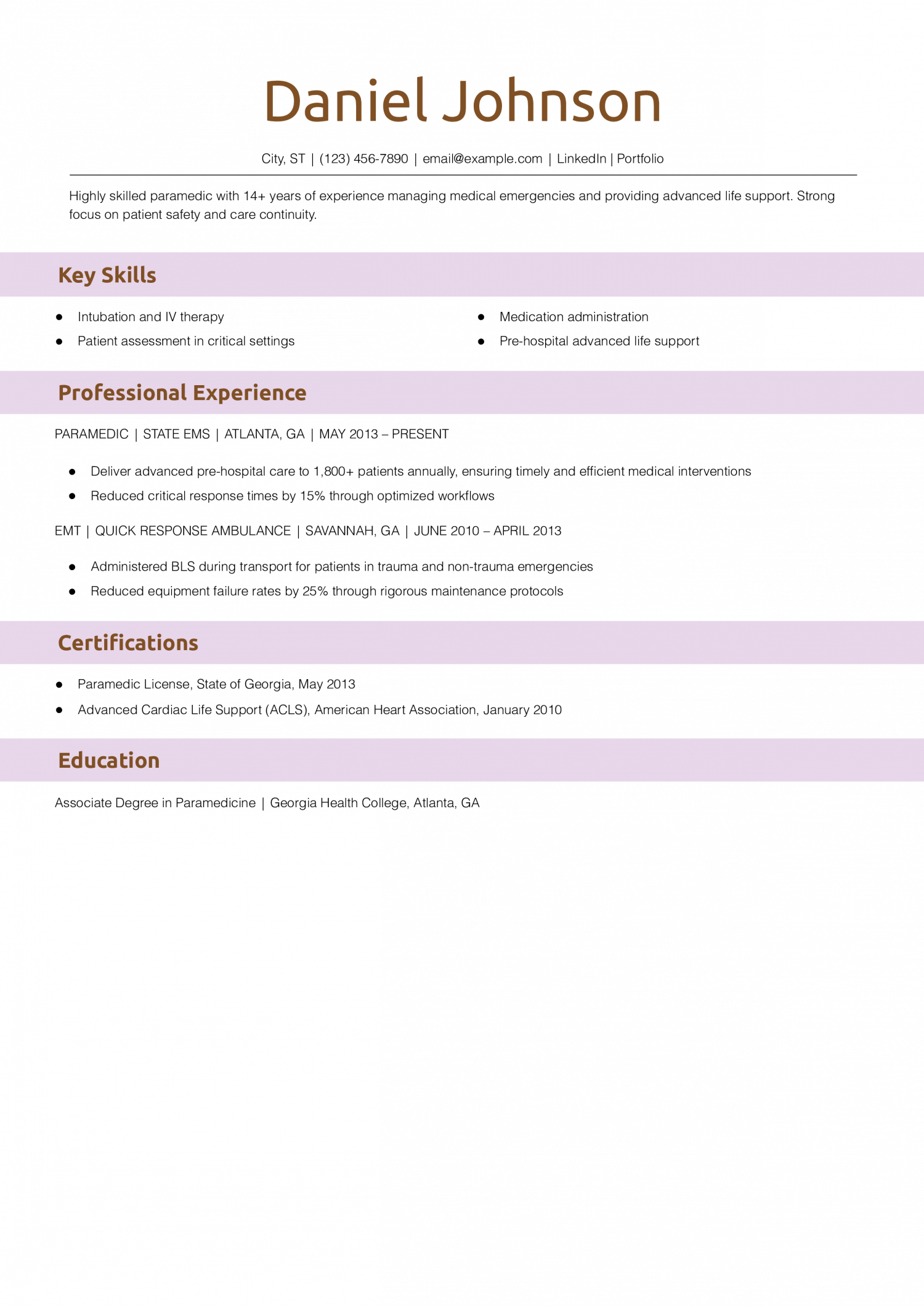
Why this EMT-paramedic resume example is strong:
This resume details advanced medical skills and leadership experience. It demonstrates the candidate’s impact on patient care and follows our advice on effective resume design.
Emergency Response Technician Resume Example
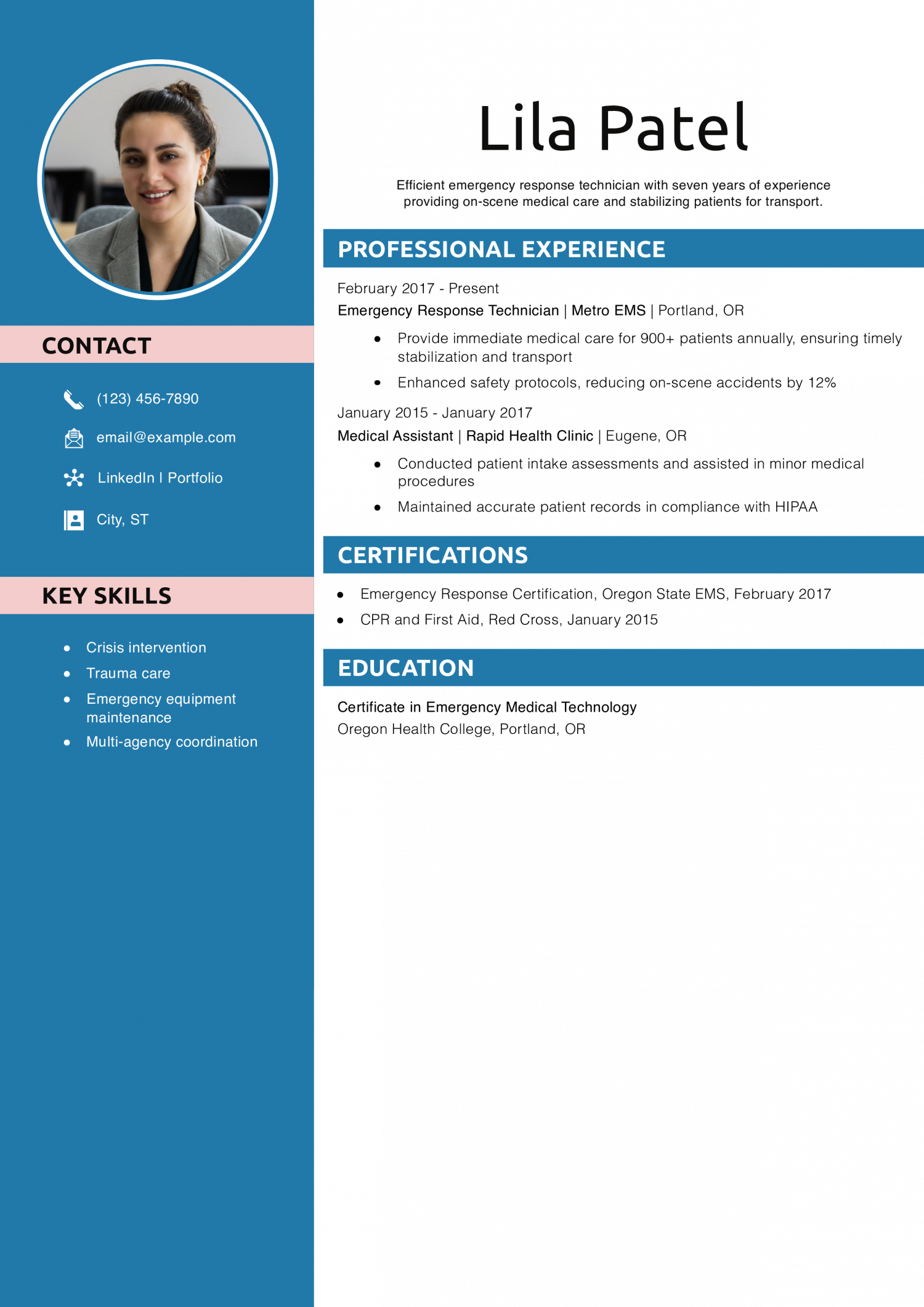
Why this emergency response technician resume example is strong:
This example emphasizes safety and inter-agency coordination, key to emergency response roles. For tips on your resume’s education section, click here.
Tactical EMT Resume Example
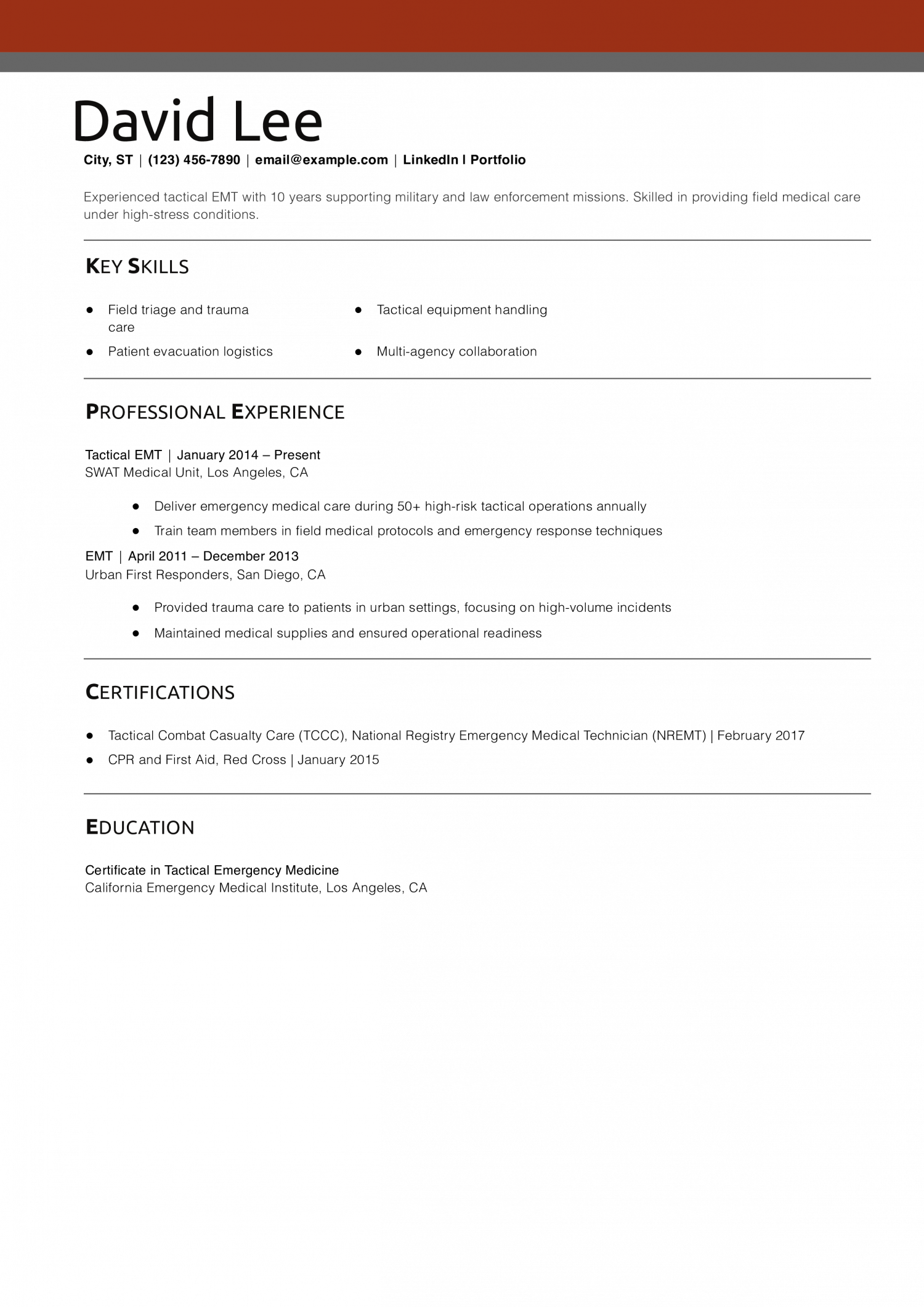
Why this tactical EMT resume example is strong:
This resume highlights specialized training and unique field experience, showcasing adaptability. The use of action verbs follows recommendations from Resume Templates.
Volunteer EMT Resume Example
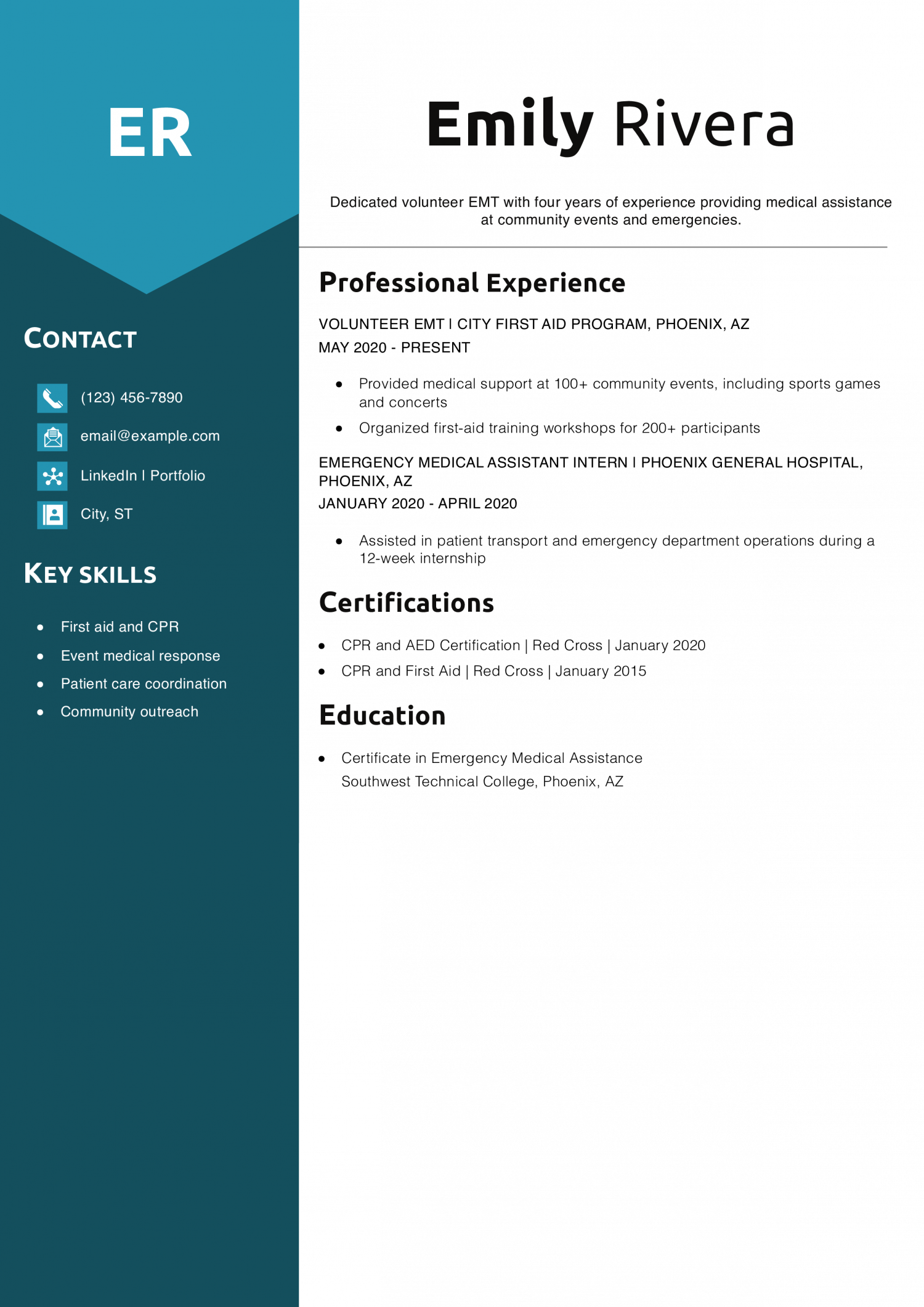
Why this volunteer EMT resume example is strong:
This resume demonstrates commitment to community service and hands-on medical experience. For tips on adding volunteer experience to your resume, click here.
Pediatric EMT Resume Example
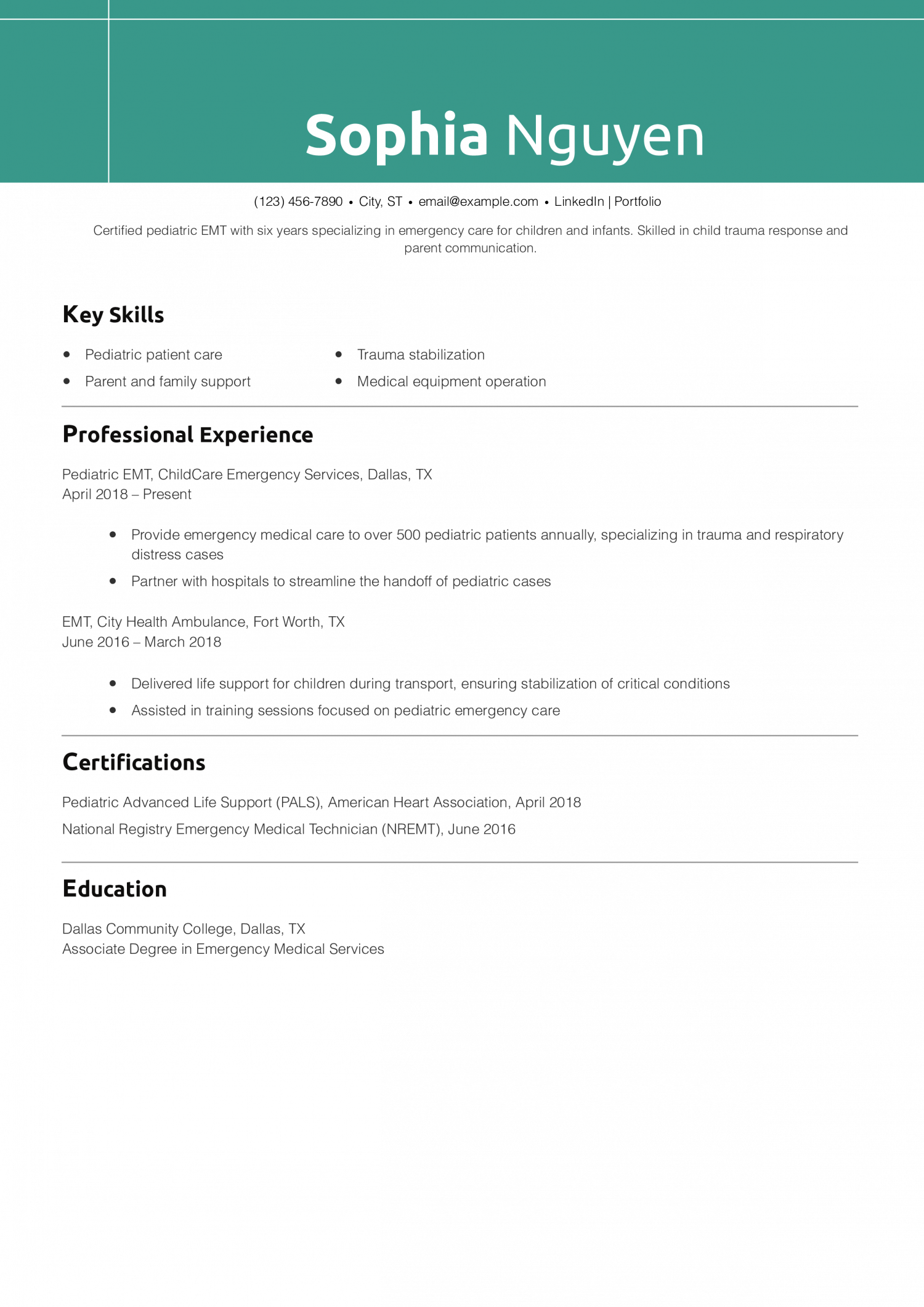
Why this pediatric EMT resume example is strong:
This resume highlights specialized pediatric care and quantifiable impact, ideal for roles requiring child-focused medical expertise. Its introductory section follows tips from Resume Templates.
Flight EMT Resume Example
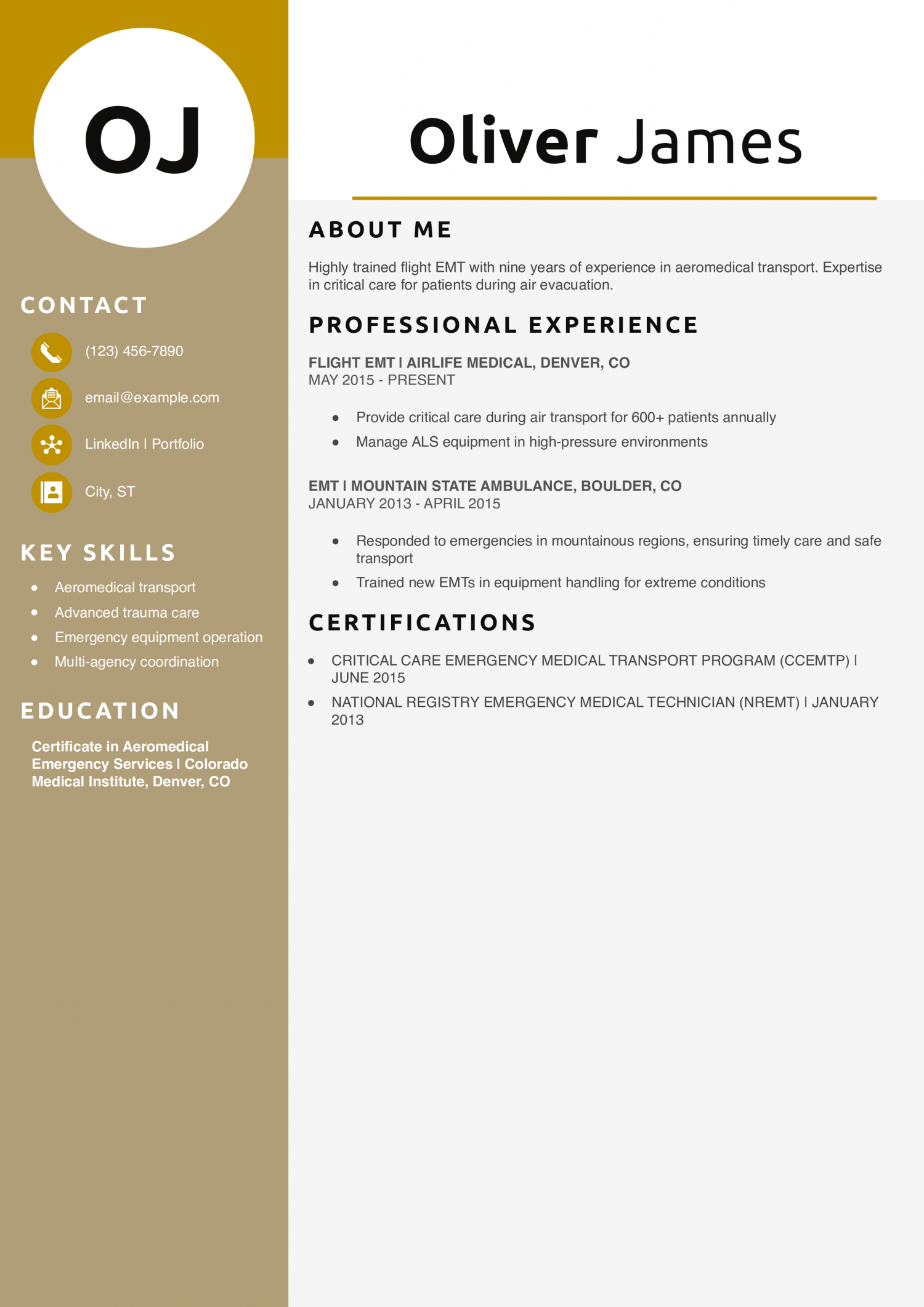
Why this flight EMT resume example is strong:
This resume showcases specialized aeromedical skills and critical care expertise, providing quantifiable success in high-stakes environments.
Event EMT Resume Example
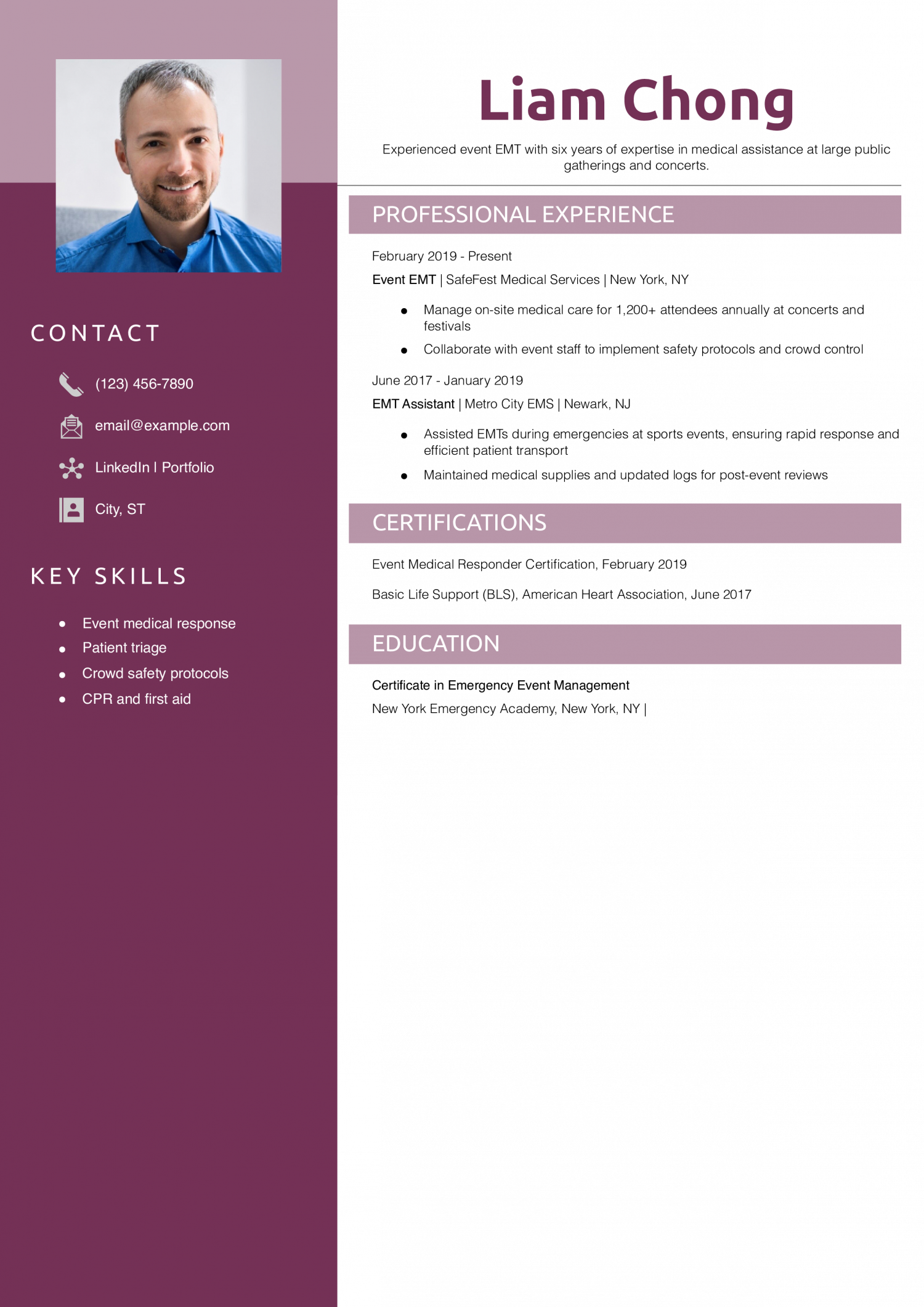
Why this event EMT resume example is strong:
This resume focuses on event-specific medical skills and emphasizes collaboration in large-scale scenarios. For advice on writing a great resume regardless of experience level, click here.
Industrial EMT Resume Example
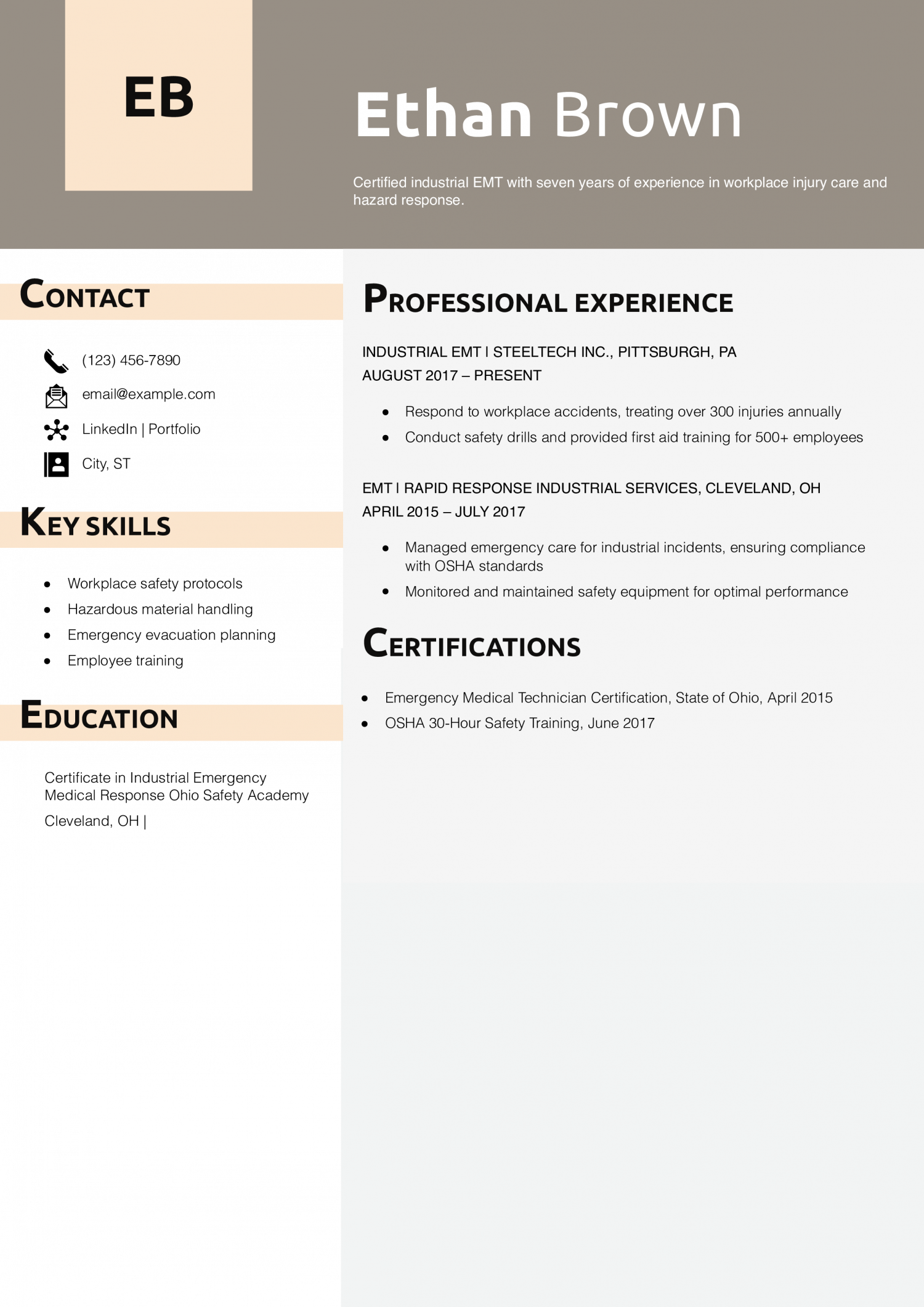
Why this industrial EMT resume example is strong:
This resume balances emergency care and workplace safety expertise, supported by OSHA training. For advice on showing your credentials on your resume, click here.
Rural EMT Resume Example
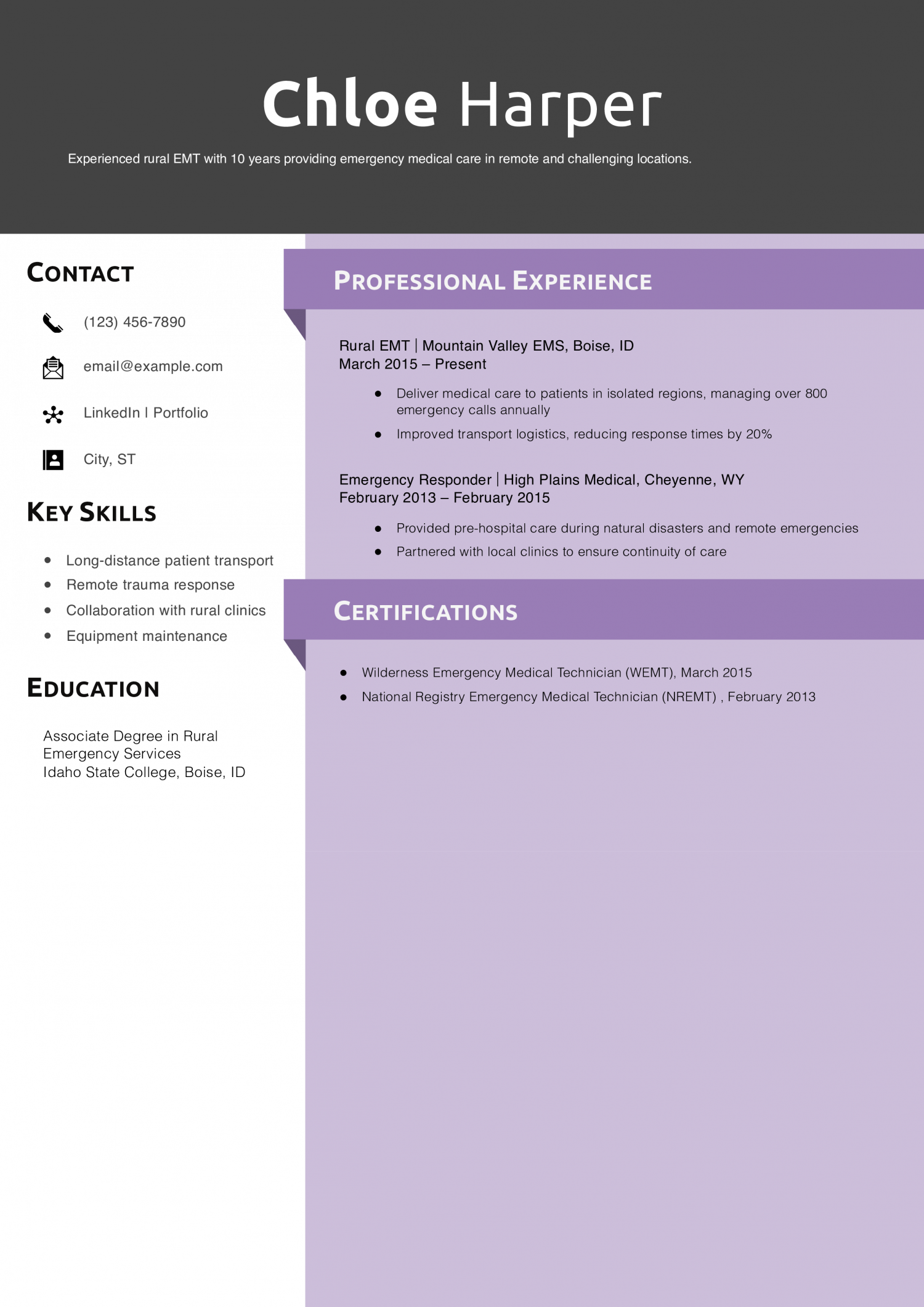
Why this rural EMT resume example is strong:
This resume emphasizes remote care expertise and logistics optimization, key for rural roles. Its job descriptions follow best practices from Resume Templates.
Search and Rescue EMT Resume Example
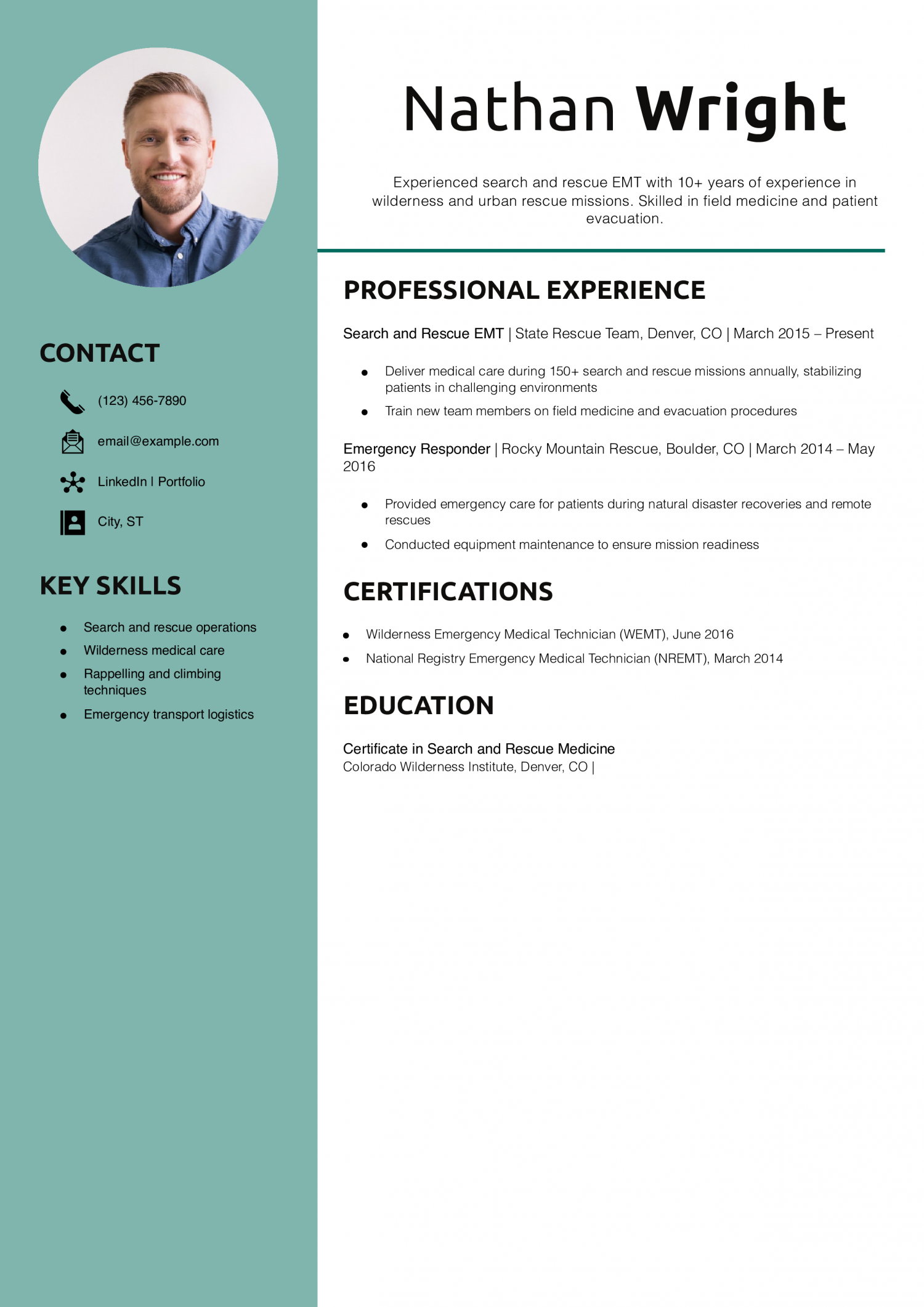
Why this search and rescue EMT resume example is strong:
This resume is well-tailored to the candidate’s goal, highlighting specialized rescue expertise and collaborative field experience.
Critical Care EMT Resume Example
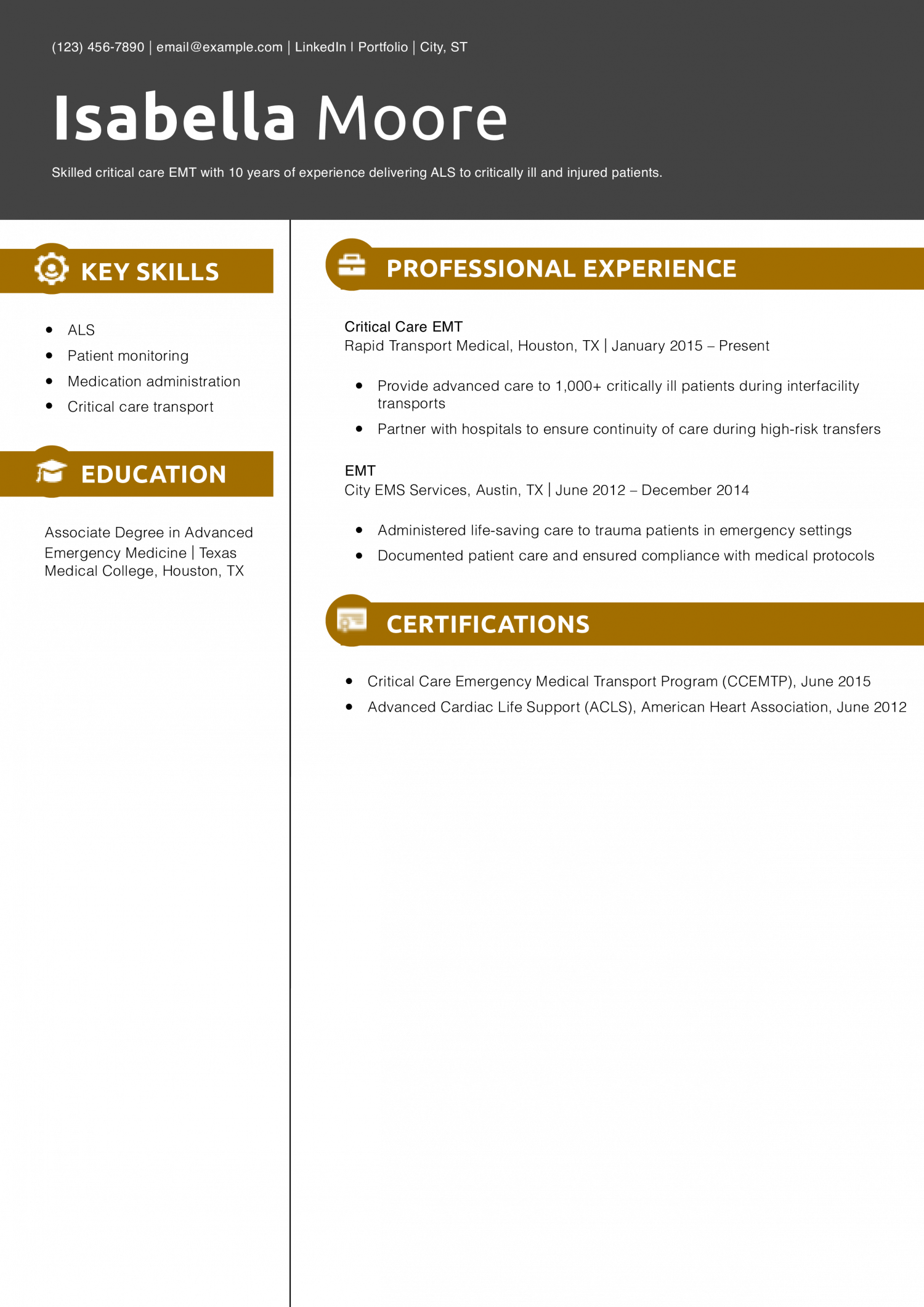
Why this critical care EMT resume example is strong:
This resume emphasizes advanced patient care skills and highlights interfacility transport experience. To know which jobs you should include on your resume, click here.
Disaster Relief EMT Resume Example
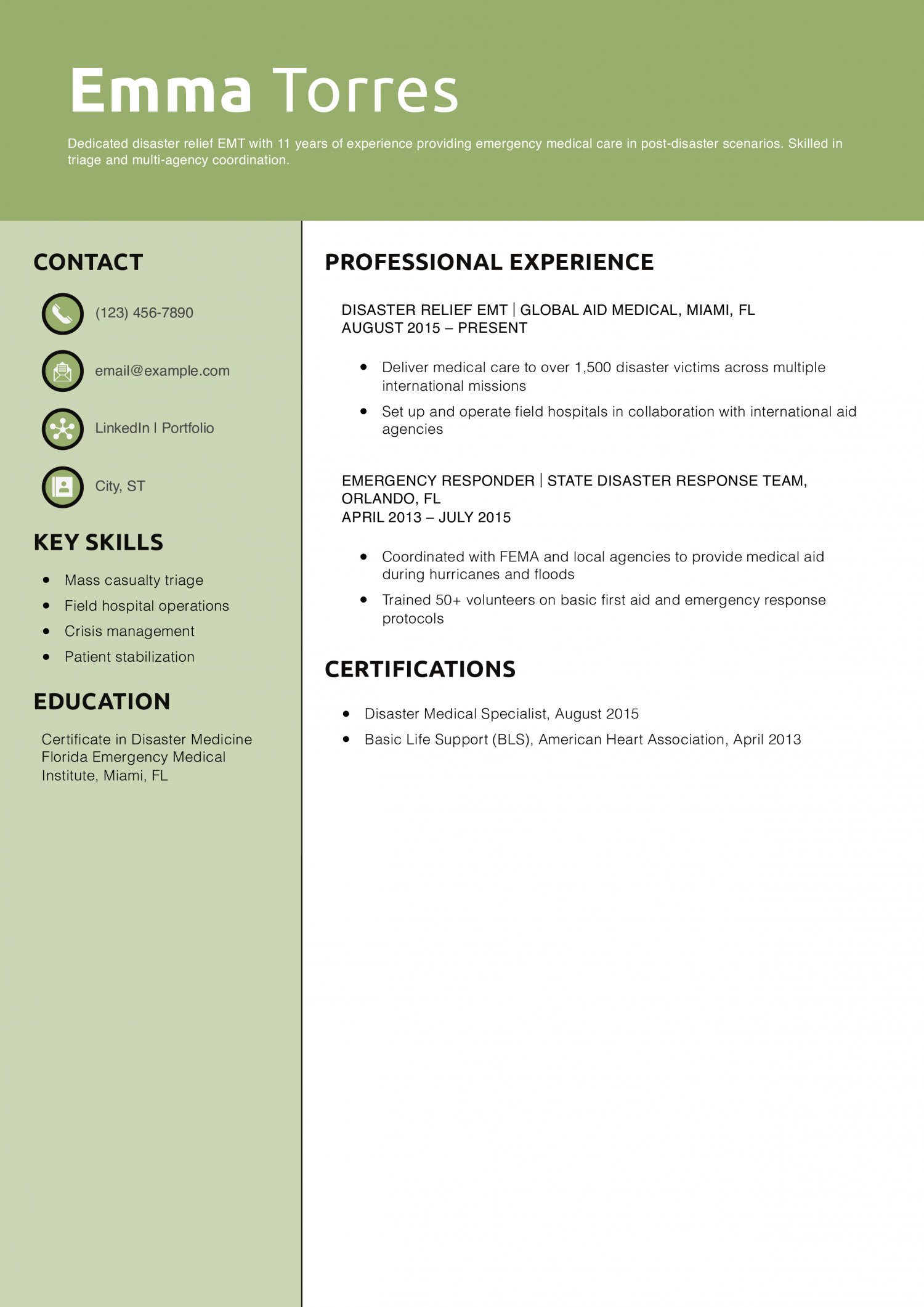
Why this disaster relief EMT resume example is strong:
This resume highlights large-scale impact and international experience, making it unique for disaster response roles. It aligns with guidance from Resume Templates on showcasing transferable skills.
Urban EMT Resume Example
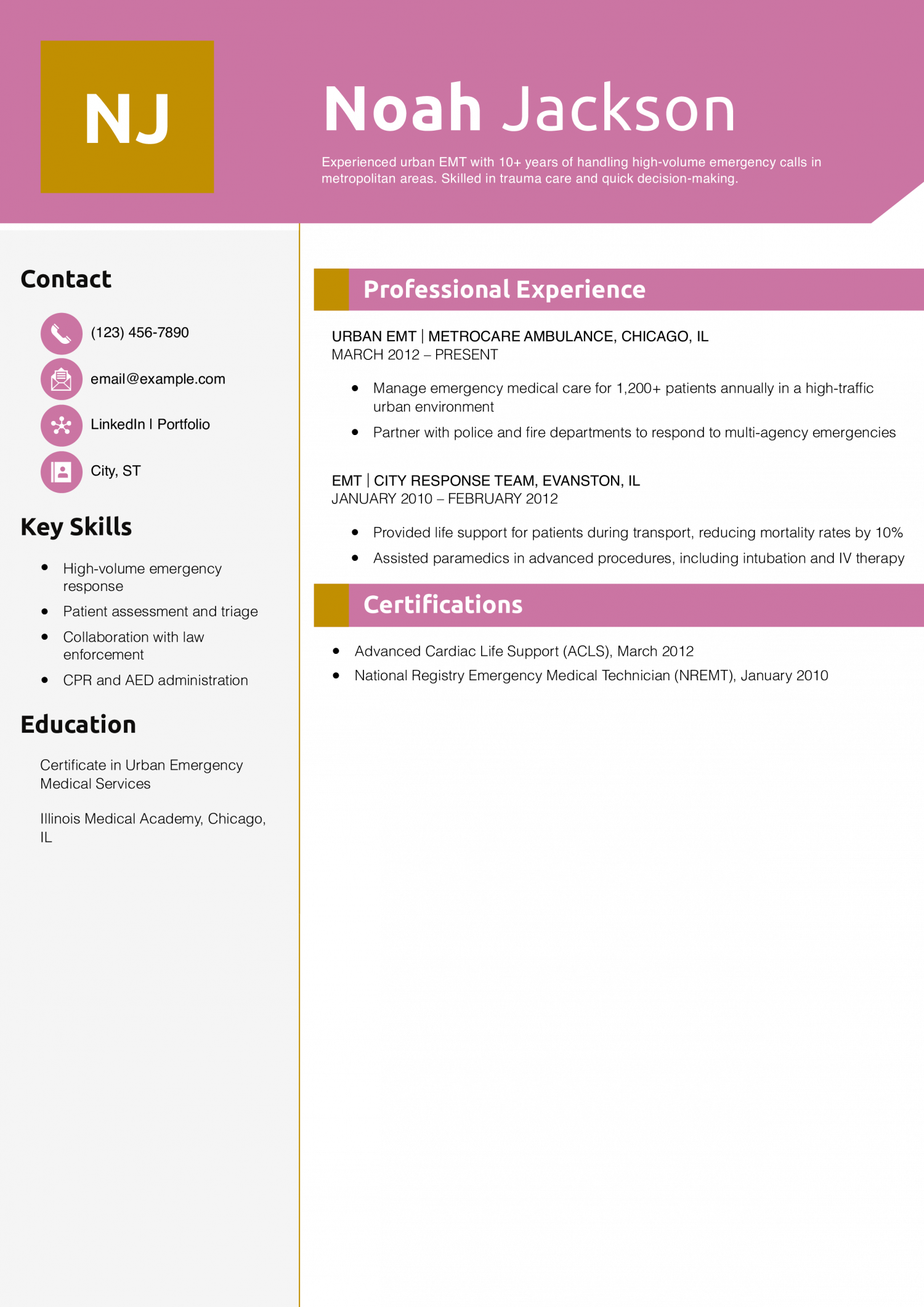
Why this urban EMT resume example is strong:
This resume focuses on urban-specific challenges and multi-agency collaboration, clearly showing the candidate’s expertise. For tips on updating your resume, click here.
Military EMT Resume Example
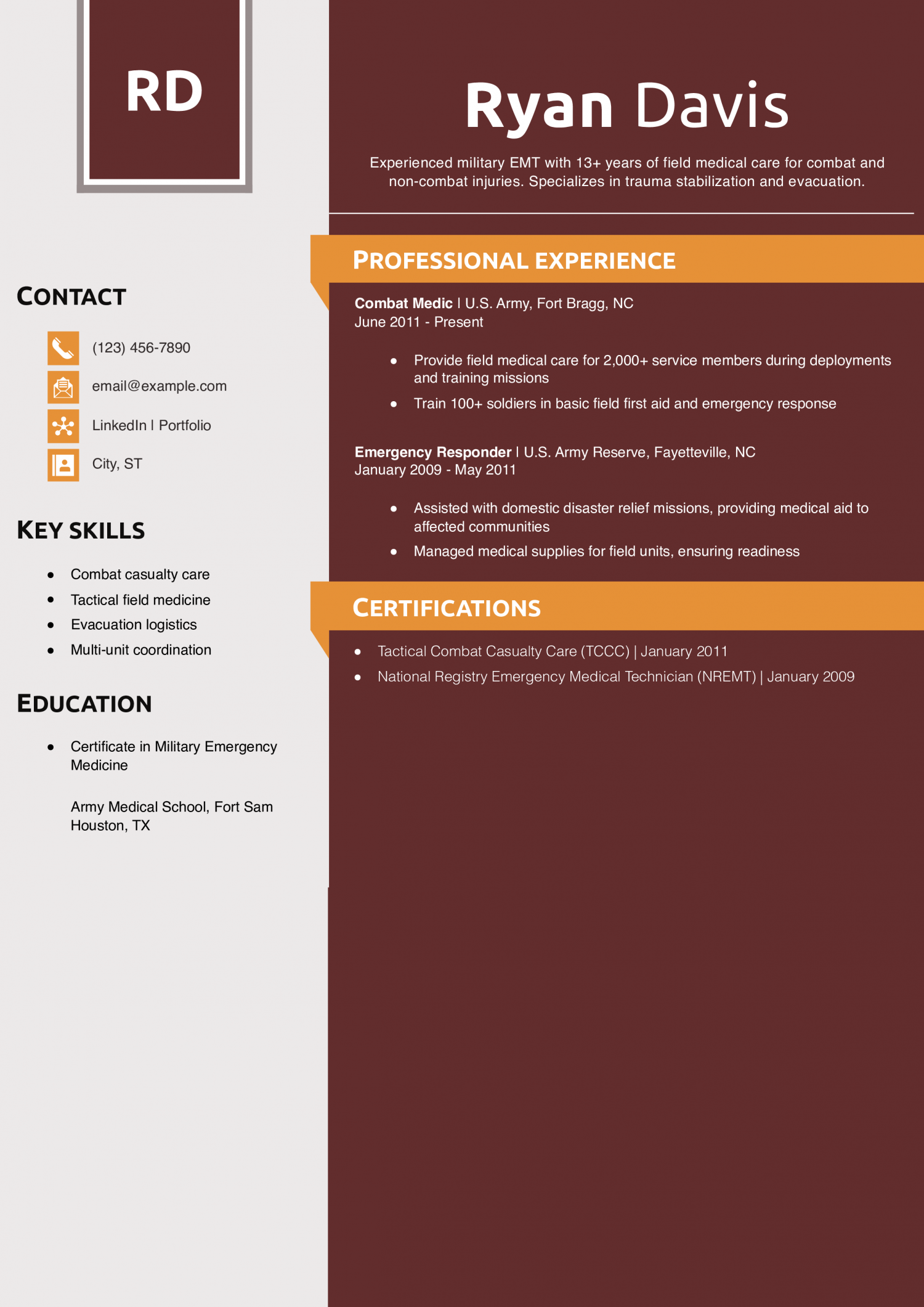
Why this military EMT resume example is strong:
This resume combines military precision with field medical expertise, demonstrating leadership and technical skills. It reflects insights from Resume Templates on effective bullet points.
EMT Text-Only Resume Examples and Templates
How To Write an EMT Resume
Your EMT resume should usually include these sections:
- Contact information
- Profile
- Key skills
- Professional experience
- Education and certifications
Below are tips and samples to help you organize each resume section.
1. Share your contact information
Give your full name, phone number, email address, location, and links to any online professional profiles. Ensure your contact information is current so employers can reach you for an interview.
Example
Your Name
(123) 456-7890 | [email protected] | City, ST 09876 | LinkedIn
2. Write a dynamic profile summarizing your qualifications
You can impress hiring managers at the top of your resume by giving the three to five primary reasons you’ll excel as their next EMT. These key selling points may include your:
- Years of EMT-related work experience
- Work style or approach (efficient, diligent, collaborative)
- Education degree(s) or certifications in your field
(Note: Most job seekers find it easier to write their profile last.)
Senior-Level Profile Example
Experienced EMT with eight years providing pre-hospital emergency care, specializing in trauma response, cardiac emergencies, and patient transport coordination. Proven ability to reduce response times and improve patient outcomes through quick, accurate assessments.
Entry-Level Profile Example
Certified EMT-Basic with hands-on training in emergency medical care, specializing in BLS, patient stabilization, and care documentation.
3. Add a compelling section featuring your EMT experience
For each job in your recent work history, brainstorm your duties and achievements on a separate document or sheet of paper. Then, review your notes in light of your target EMT job, and choose the most relevant ones to feature as bullet points in this section. By filtering your information this way, you can create a detailed and focused experience section.
Senior-Level Professional Experience Example
Paramedic, Citywide Ambulance Services, New York, NY | August 2015 to present
- Deliver emergency medical care to over 1,200 patients annually, ensuring patient stabilization and safe transport to hospitals
- Collaborate with fire and police departments during multi-agency emergency responses to improve efficiency and coordination
- Trained and mentored new EMTs, enhancing team readiness and patient care quality by 25%
Entry-Level Professional Experience Example
Emergency Medical Technician (EMT-Basic), Fast Response Ambulance, Los Angeles, CA | July 2022 to present
- Provide BLS for patients during transport to medical facilities
- Maintain medical equipment and restocked supplies to ensure operational readiness
- Assisted paramedics during advanced life support (ALS) procedures in 100+ cases
Resume writer’s tip: Quantify your experience
When possible, use relevant performance data to measure your EMT results. Hard numbers and percentages put your work in context and give recruiters a better sense of your scope and impact.
Do
- “Reduced average response time by 20% through streamlined dispatch coordination”
Don’t
- “Improved efficiency”
Resume writer’s tip: Tailor your resume to each application
Before sending your resume, review it carefully against the job posting. Delete any details that don’t speak to the requirements, and consider using that space for more information about your relevant experience. This process takes extra time. But it can shorten your overall job search by giving you an edge over the many applicants who send a more general, less convincing resume.
What if you have no experience as an EMT?
Writing a resume can be hard if you don’t have real-world experience. But remember, you still have valuable skills and knowledge from your education and training. Include any relevant coursework you’ve done or certifications you’ve earned. Also, describe volunteer roles or internships you’ve completed in your field, and emphasize your work ethic and willingness to learn. By focusing on these qualities, you can show you’d be an asset to any team.
4. Include education and certifications relevant to an EMT
With the education and certifications sections, you can show you have a strong knowledge base in your field. Each degree or credential also serves as a formal endorsement of your skills and professionalism. Following are templates to help you organize this information on your resume (note, years are optional).
Education Template
Template:
[Degree Name]
[School Name], [City, State Abbreviation] | [Graduation Year]
Example:
Associate Degree in Emergency Medical Services, Community College of Health Professions, Chicago, IL
Certifications
Template:
[Certification Name], [Awarding Organization], [Completion Year]
Example:
Basic Life Support (BLS), American Heart Association | 2021
5. List EMT-related skills and proficiencies
A separate skills section lets you quickly display the ways you can contribute as an EMT. Below, you’ll find some key terms and skills to consider for this section:
| Key Skills | |
|---|---|
| Advanced cardiac life support (ACLS) | BLS |
| Emergency patient assessment | Medical equipment operation |
| Patient stabilization and transport | Pre-hospital care documentation |
| Trauma response | Vital signs monitoring |
Resume writer’s tip: Use descriptive action verbs
Start each bullet point with a strong action verb. Dynamic verbs help you keep the hiring manager’s attention and show the varied nature of your experience. The following list can help you find a good mix of action verbs for your EMT resume:
| Action Verbs | |
|---|---|
| Created | Decreased |
| Enhanced | Evaluated |
| Fostered | Generated |
| Improved | Increased |
| Introduced | Lowered |
| Managed | Monitored |
| Prevented | Ranked |
| Reduced | Responded |
| Reversed | Stabilized |
| Streamlined | Supported |
| Transported | Updated |
| Won | |
How To Pick the Best EMT Resume Template
Choose a clear and straightforward template, and avoid any template with elaborate graphics or various colors and font styles. Simple resume design helps a hiring manager scan for relevant information. It also helps you tailor the document to each job application and update your work history going forward.
Frequently Asked Questions: EMT Resume Examples and Advice
Focus on editing your skills section. With a few quick changes to this section, you can hone your resume and help it get past screenings by applicant tracking systems (ATS).
First, look closely at the job posting and highlight any required skills. Then, compare those highlighted terms against your resume's existing skills section. Delete any skills from your list that don't appear in the job posting, and add any missing skills of yours that do.
Say the job posting calls for experience in training new hires, which you have. Add the phrase "New hire training" to your skills section so ATS and human readers can see you have the leadership ability they want.
Creating a EMT resume example that stands out involves focusing on your unique contributions. Whether you've worked in leadership, handled large budgets, or managed complex projects, showcase your experience with measurable results. Include your proficiency in relevant tools and technologies, and make sure your resume reflects your career trajectory in a clear and concise manner.
A combination resume has these two features:
- An introduction to your strengths. Typically, the resume intro consists of a profile paragraph and skills list, as in the examples on this page. But there are many variations. Depending on your job search, you may omit one or both of these sections in favor of a one- or two-sentence professional headline. Whatever approach you choose, make sure your introduction tells why you're great for the job.
- One or more experience sections. Hiring managers want to know your latest career activities. The combination format lets you provide that information with sections for your recent years' work, internship, education, or other experience. For most job seekers, the bulk of their combination resume will be a "Professional Experience" section with detailed job descriptions in reverse-chronological order.
Include a cover letter with your resume
A good cover letter sharpens your job application by directly explaining why you’re interested in the organization or job opening. When possible, quote or paraphrase text from the job posting and explain why it caught your attention.
Check Out Related Examples
Resume Templates offers HR approved resume templates to help you create a professional resume in minutes. Choose from several template options and even pre-populate a resume from your profile.

